

What Is Genius Hour and How Can You Use It? (350+ Genius Hour Ideas)
- April 10, 2022
- Teaching Kids
Genius Hour is a powerful tool that every educator should be implemented in their class.
How it works is very simple. Students decide on a project that they can work on independently or with other students during a specific time period in the classroom.
When we ask kids to think outside of the box, we must also allow them to be encouraged to do it in a way that suits their personality. This is where the genius hour comes into place.
The basic idea of genius hour is for students to choose a topic about which they want to learn, explore, and create something new.
Genius Hour allows kids to be creative and innovative. It allows them to learn more about things that interest them than what they were required to learn in class.
They can also use their creativity and skills in language arts, math and science during this time to research, develop questions, create projects and solve problems around the subject of their choice.

Purpose of Genius Hour
The main purpose of Genius Hour is to allow students to learn deeply through inquiry on topics they find interesting. This type of learning allows students to become invested in what they are wanting to learn about because it comes from within them.
In addition, the Genius hour also helps in,
Motivation and engagement – students will be engaged in their learning because they will be doing research on a topic that interests them.
Student choice and voice – students get to choose what they learn. They can go as broad or as narrow as they wish with the topic and decide how deep they want to research.
Creativity – this is time for kids to express themselves through writing, art, or video on a topic that is important to them.
Collaboration – during Genius Hour, students can come together and share their passions. This may lead to group projects, sharing of ideas, and brainstorming sessions.
Teacher collaboration – teachers can collaborate with each other within the same school or from different schools around the world. They can learn from each other’s Genius Hour projects and share resources.
Steps to Include Genius Hour in Your Classroom
There are many ways to include genius hour into your classroom schedule. It can be a weekly hour-long activity, a daily 30-minute session, or even an entire class period once a month. Find what works best for your classroom.
Here are some steps that you can take to conduct a Genius Hour in your classroom:
Step 1: Introduce the Idea to the Class
Explain to your students what Genius Hour will be like and what you expect of them. I also made sure to talk about how Genius Hour is a time for them to learn about things they love, not just Google things they already know!
Make sure that students understand the purpose and value of Genius Hour.
Step 2: Brainstorm & Finalize the Topics with Students
Allow time for students to brainstorm ideas. Consider using a tool such as Peardeck or Socrative to help them narrow down their ideas to just one.
Have students do some sort of interest survey. I chose to have them fill out a short questionnaire on Google Forms.
This allowed me to sort their responses by interest, so I could easily tell which the most popular topics and which students were interested in the same things.
Break into groups with similar interests and research together.
I decided that each group would need a minimum of three students since they would be working together on their projects at the end of this phase as well.
You can also allow students to work independently without a group setting.
Have students decide on a final topic and start working on their project.
I think it’s important for kids to pick their own topics because it makes them more invested in their own learning. (It’s also important for teachers to make sure that the projects are feasible!)
Step 3: Create the Product / Complete the Project
Let your students Continue working on projects for the next several weeks during Genius Hour time (which can be once or twice a week – 30 mins or 1 Hour).
Give students time, space and materials to work on their projects.
Students can work individually or in small teams depending on the type of project they are doing.
Provide support and guidance as needed throughout the process.
Check-in with students regularly to help them stay on track and answer any questions they may have along the way.
Step 4: Assessment / Share the Project Outcome or Product Created
Allow students to choose how they want to share their learning.
Students should share their learnings with the class in some way — whether that be a formal presentation or an informal chat with classmates about what they learned during the process.
The outcome should be measured in terms of the learning that the student has achieved not by any other means.
Ideally, the whole exercise should help them develop interests that are personal and meaningful to them. Nothing else matters.
Why is it important to let kids come up with their own ideas?
Allowing kids to choose their topic allows a new dimension of learning. For example, it would be difficult for me as an adult to learn about the solar system because I know so much about it already.
But if I had been interested in that topic as a child, and if my parents or teachers had helped me expand on that interest and create learning opportunities, I might still find that topic interesting now and have learned even more than I did in school.
In addition, they are more likely to complete the project. If kids choose the project, they are going to work on during Genius Hour, they will be far more excited about it than if an adult chooses it for them.
This is important; without completion, students miss out on the chance to publish their work and share it with others who might be interested as well!
Role of a Teacher
The role of a teacher in Genius Hour includes the following:
Be a Facilitator
The role of a teacher in Genius Hour is to create an environment that allows students to discover their interests and ability, and also to provide great feedback on work that has been produced.
Transfer ownership to students while helping them maintain the course and stay on task. Because it is so important for our students to feel empowered in their learning.
It means taking risks in their learning and exploring topics that are of interest to them.
It also means that they need to be able to self-assess and revise their work based on where they think they should be going with it rather than where I think they should be going with it.
Be a Guide / Coach
Teach Students How to Research.
When students are working on their projects, as a teacher you can be there to guide them through each step and make sure they are staying on track with their work.
Teachers should be extremely approachable, and willing to listen and respond to students’ ideas and questions.
Teachers should also share what they know about their subjects in order to help students develop those interests.
You can also have many discussions with each student and assess learning by looking at student work samples or discussing student thinking and learning along the way.
Provide students with the tools, books, websites, apps, people and spaces that they need to be successful.
Manage Time / Be Accountable
It is the teachers’ responsibility to be a gatekeeper of time and be accountable for the outcome.
Work with each student so that they complete the whole process in time and be able to present it back to the class.
Create and maintain an environment of trust and respect.
It is ok to watch what they are doing and provide feedback occasionally. However, ensure that the students stay on track with the chosen topic.
Make sure the students reflect on their learning process.
Role of a Student in Genius Hour
It is important for students to understand the role they play in Genius Hour. They will be asked to take on different roles as the learning process moves along. There are three main roles that students can play during Genius Hour:
The Leader/Manager/Producer
The student(s) who will be responsible for organizing and managing the project from beginning to end. This role may change as the project progresses.
The leader might also have a hand at making, but this person must have a vision or goal for the group.
The Designer
The person who designs the finished product of the project. This could be someone who makes something that is tangible, like building a model or designing an app. Or it could be someone who organizes an event and works out all of the details to get it set up and implemented.
This person needs to have good ideas, creative thinking skills and problem-solving skills.
The Researcher
The student on the team researches information and data related to the topic or issue being explored by the team.
This person needs to be a critical thinker and good with technology so that he or she can research topics thoroughly and evaluate sources for accuracy and bias.
Genius Hour Ideas

Genius Hour Ideas (Gradewise)
If you are a student/teacher from Grade 1-10, and you are looking for some interesting ways to spend your Genius Hour, here is a list of ideas that you can use.
Genius Hour Ideas for Elementary
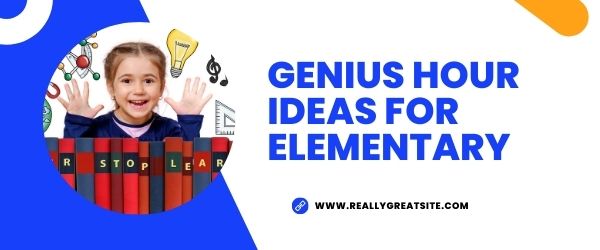
Kindergarten/First
- How to do … (anything!)
- Birds in Georgia
- My family tree
- How to take care of a pet
- What I want to learn about this year
- Animals in the wild
- How to plant a garden
- Favourite book characters
- Writing letters to family members or friends (or video chat)
- Favourite books or authors
- How letters make words and words make sentences
- How to make paper planes
- How to make a kite
- How to make cupcakes
- How to draw a rose
- How to draw a bicycle
- Birds of North America
- Learn – Why are tornadoes so destructive
- Take a good photograph
- Explore stars
- How to bind a book
- How to make paint
- How to make ink
- Make a playdough
- Learn about volcanos
- Learn about turtles
- Sew a dress for a doll
- Make Jewelry
- Knit a sweater
- Write a chapter book
- Learn the causes that make the days get longer and shorter
- Learn how the heart pumps blood across the body
- Learn to knit
- Learn to crochet
- How to solve Rubix cube
- Learn to set up a garden and grow plants
- Make homemade slime
- Research a historical place or event
- Explore an animal’s habitat.
- How the world is rotating and why we don’t feel it
- What makes birds fly
- From where do butterflies get their colours
- Make a photo collage book.
- Ways to help endangered animals
- How to make natural compost
Genius Hour Ideas for Middle School

- Learn how the moon affects the Earth
- Conduct a science experiment
- Understand the effect seasons have on our planet
- How to create a map
- Learn how to do Origami
- Do a community service
- Use natural colours to dye clothes
- Create your own toy
- Read and discuss World Wars
- Become a magician
- Learn to do ice skating
- Contribute to environmental protection
- Learn to become a Lego master builder
- Enquire – how are dreams made
- Learn to create a PowerPoint presentation
- Create a lesson plan
- Create a new course (for your favourite hobby like sewing, knitting, etc.)
- Learn to do a puppet show
- Create a new recipe
- Make a website for the class website.
- Write a short story
- Write a skit
- Write a speech
- Study about Carnivorous plants
- How pollination helps
- Disassemble and assemble a mechanical device
- Code a computer game
- Learn to create a website or blog
- Learn about the reasons some animals are extinct
- Teach someone how a thermos work
- What role does science play in music, sport or another hobby?
- History of NFL
- Science behind golf
- Global Warming
- Find a solution to reduce the litter in your school permanently
- Learn how does the brain work
- Different foods from different parts of the world
- Learn to play the guitar
- Design a book cover
- Start a school club
- How glasses are made
- Create a movie trailer with PowerPoint
- Learn to dance
- Create new cartoon characters
- Do a renewable energy project
- Find new ways for energy conservation
- Run a charity event (concert, run, walk, drive, etc.)
- Learn and teach a coding lesson
- Explore and explain how a phenomenon works (electricity, cyclone, volcano, solar energy, etc.)
- Conduct a virtual field trip
- Build a remote car
- Create a basic electronic circuit
- Research future career ideas
- Research how to make something
- Learn a new language
- Learn to do Yoga
- Develop a science group for middle school
- Write a song
- Learn to skateboard
- Discover effective ways to lose weight
- Conduct a social experiment
- Make a short movie
- Create a…. out for recyclables
- Discover ways to balance my budget
- Learn about the causes and preventions of cancer
- Make people aware of global warming
- learn how to create an app
- Benefits of Electric cars
- How is Plastic made
- How Aerodynamics affect football game
- Learn to create a video game
- Create a campaign to reduce bullying in my school
- How clothes are made
- Write a book
- Explore the need for sleep
- Why seat belts are important
- Discuss the future of schools
- Why bees die after they sting
- Write a poem
- Create and run an online newspaper for your school
- Write a script
- Run a fundraising project
- Create a Claymation video
- Create a concert video
- Make a YouTube video
- Interview a famous personality
- Create a manifesto for your school club
- Design a pamphlet for your school event
- Photography exhibition
- How to recycle…
- How to remove plastic from the sea
- Make a stop-motion movie
- Make people aware of the dangers of smoking
- Explore how the mind works
- Create a wellness plan
- design a textbook that is exciting
- Learn to become a professional sportsperson
- What exactly happens when a bone heals after being broken?
- Build a sustainable garden that provides ingredients to reduce our food expenses
- Create your own board game
- Explore the theories behind the origin of the world
- Learn how stock markets work
- Make a musical out of a storybook
- Create a google break-out room
- Research whether different colours change the opinions/moods
- Invent a language
- Create a new sport or game
- How to prevent animal abuse
- Animal Shelter
- How to design accessible building plans
- Study and Understand Cancer
- Study on Homeless People
- Ways to prevent Alzheimer’s
Genius Hour Ideas for High School
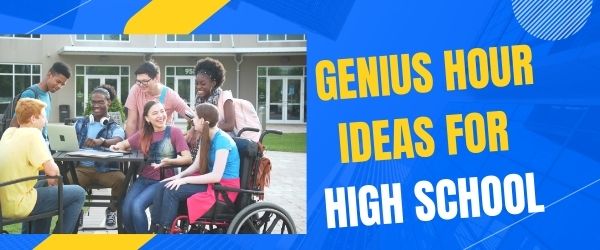
- Study fashion and start a YouTube channel
- Learn sign language
- Lean on the impact of technology on human life
- Explore the concepts behind black holes formation
- Create an art
- Explore Self Driving Cars
- Write a script for a short film
- Dive into photography and become an IG influencer
- Create your own invention
- Are vaccines safe?
- Understand the importance of DNA
- Learn to understand Virtual Reality
- How to resolve Video Game Addiction
- Conduct an event in school
- Discover solutions for the world’s biggest problems like poverty, pollution, etc.
- Study climate change and start a student-driven nonprofit
- Learn how to make sourdough bread and start a small bakery business
- Explore video game design
- Start your own Podcast
- Learn how to build furniture
- Learn to do Vlog
- Plan and create a 3D printing structure
- Watch / Plan for a Ted Talk
- Learn to become an author
- Learn to become a master chef
- What are the challenges in travelling to mars?
- Create a new product
- Design a store along with business plan
- Create your own robot
- Research on how to start a business
- Draw an original cartoon about what you like to do at school or what you’re proud of doing in your life.
- Learn to fill out applications and apply for an interview
Genius Hour Ideas Based on Subject
Math genius hour ideas.
Math is a difficult subject for many people, so it can be difficult to find genius hour idea for math. These are some of the best math-based projects that people have worked on during their Genius Hour.
- Write a math poem
- Create a math puzzle
- Write a math joke or limerick
- Create a math magic trick
- Create a math invention
- Create an artwork based on the Fibonacci Sequence or Golden Ratio
- Share the history of your favourite mathematical theory and/or mathematician.
- The Golden Ratio: Build sculptures using this ratio in nature and art.
- Design a math-themed T-shirt (and sell it)
- Make a math video game
- Explain how your use of a specific mathematical concept has changed your life.
- Demonstrate how to apply a mathematical concept to a real-world problem.
- Explain how you would teach someone else how to use this mathematical concept or idea to solve a problem.
- Explore the history of pi
- Explore the history of zero
- Learn – How to draw a circle without using a protractor
- Learn – How to find the area of a triangle without using a formula
- Find ways to use math in your daily life
- Write your own math textbook
- Learn about the history of numbers and counting systems
- Write a children’s book about mathematics
- Create an app that teaches people about math concepts or helps them solve math problems
- Calculate the probability of winning your favourite lottery game with different combinations of numbers
- Create a colour-by-number picture using fractions as the colours
Animal Genius Hour Ideas
Below are some possible animal genius hour ideas that students have actually completed or have been requested by students in our classroom.
- Research animal communication and create your own way that animals communicate.
- Create a new animal species
- Create a nature journal showing how plants and animals in your area change over the seasons.
- Learn – How to train a dog
- Make a bird feeder and observe the birds that come to it.
- Make a list of all the animals that live in your area and find out about them (habitat, eating habits, etc).
- Observe the insects that live in your neighbourhood and draw a picture of them.
- Find out about bats and how they are important to our ecosystem.
- Find out about endangered species in your state or country and explain why they are endangered. What can be done to protect them?
- Find out about different types of dogs and their purposes – how do they help humans?
- Learn about horses and how they were important to people in the past (and now). What breeds are there? What are they used for?
- Learn more about sharks – what type is the biggest? The smallest? The most dangerous? How many species are there? How do they eat? Do they have babies or lay eggs? Are some species endangered?
- Learn more about penguins – where do they live? What do they eat? Why can’t they
- Learn – Why do birds migrate?
- How does a bird fly? How does a bat fly?
- Why are some animals nocturnal and others are not? What makes an animal nocturnal?
- Create a poster on endangered animals
- Spend time helping at an animal shelter
- Create a poster on different species of whales
- Research animal adaptations
- Make an informational video on cats and dogs
- Write a persuasive essay on why people should adopt pets instead of buying them.
- How does the food chain work?
- Which animals belong to which classifications: kingdom, phylum, class, order, family, genus, species.
- Do animals like music?
Baking genius hour ideas
This list of baking genius hour ideas is meant to inspire and ignite your passion for baking. I hope that these ideas help you get started on your personal project.
- Learn how to make a vegan cake and share the recipe
- Learn how to make a gluten-free cake and share the recipe
- Learn about icing types and write a blog post about it
- Learn about meringue and write a blog post about it
- Learn how to use fondant and write a blog post about it
- Learn how to decorate cakes with fondant
- How to make rainbow cakes
- How to make a birthday cake
- Making pie crust and decorating pies
- How to make hamburger cupcakes and nacho cupcakes
- How to make cake pops
- How to make flowers for a cake and write on a cake
- Learn How to Create Cake Pops
Genius Hour Ideas about Food
I really like food. I know other people who like food as well. So, I thought it might be fun to have a Genius Hour about food.
Maybe we could try baking something new or making a recipe that we’ve never done before. Or maybe, we could look at different types of foods and talk about what people like about them and why they do or don’t like them.
- Create and share recipes that worked for you.
- Create your own recipe book – cookbook.
- Share your cookie recipe with the class, friends, and family members.
- Improve existing recipes (i.e. substituting ingredients)
- Teach others how to bake certain recipes
- How to make homemade ice cream
Here are some things you can research:
- Why do people love junk food? How can you make junk food healthier?
- What makes fast food so unhealthy? What can you do to make fast food healthier?
- What are the health benefits of eating different foods?
- What is the most nutritious snack?
- Why is it important to eat healthily?
- What are some good snacks to have in the classroom?
- How much sugar is in popular beverages?
- What is your favourite fruit? Why do you like it?
- What are some good things to eat during lunchtime at school?
- How can we encourage our classmates to choose healthy foods over junk food?
- Are there any healthy foods that taste bad that we could make taste better? How would we make them better? Can we make them healthier at the same time?
- Which foods are the healthiest for growing brains and bodies and why?
- Find healthier alternatives for some of your favourite high-calorie foods, like swapping full-fat cheese for low-fat cheese, or grilling rather than frying
- The history of your favourite type of cuisine. Where did it come from? How did it spread around the world? What different types exist today?
Baseball genius hour ideas
- The Science of Bat Speed
- The Science of Pitch Velocity
- How to Best Use Video Analysis to Improve your Swing
- How to take care of baseball equipment/clean it/what is the best way?
- What is the history of baseball in America? (video making)
- How to teach the best baseball swing
- How has technology changed the game? (radar guns, cameras, etc.)
- The history of baseball in Japan, Cuba, and other countries.
- The history of your favourite team.
- What is the most important statistic in measuring a pitcher’s success?
Chemistry Genius Hour Ideas
A lot of chemistry teachers are doing genius hour projects in their classes. This is a great way to get students thinking about chemistry and applying what they know and what they want to learn about chemistry.
The following are ideas for Genius Hour Projects in Chemistry:
- How does the concentration of a solution affect its freezing point?
- What is the ideal ratio for homemade slime?
- What is the ideal ratio for homemade silly putty?
- How does the concentration of vinegar affect how long it takes to dissolve an eggshell?
- Does the amount of sugar added to lemonade affect its taste?
- Does the amount of sugar added to lemonade affect its resistance to spoilage?
- How does heating or cooling effect soda pop?
- Can you make candy at home? How much sugar, corn syrup and water do you need? What temperature should the mixture be heated to?
- Make a chemical volcano and explain what happens with different types of acid and bases.
- Explain how to make fireworks and explain the science behind them.
- Explain how dyes work on fabric/paper and then test different chemical compounds to see if they will dye fabric/paper.
- Explain how soap works and then test different chemical compounds to see if they can clean something dirty (dish soap, shampoo, hand soap, etc.).
- Make slime, silly putty, or jello with things from home using chemicals that you can find at home ( baking soda and vinegar).
- What is the science of making a cake?
- What is the chemistry of soap making?
- What are the chemical reactions that occur when you cook food?
- Hacking photosynthesis
- Creating a battery out of fruits and veggies
- Making a solar oven to cook with the energy of the sun
- Measuring the pH levels of your favourite drink
- Designing a new way to filter water
- How to make glue from milk
- How to make plastic from milk
- How to make butter from cream
- What are different types of plastic, and how is each one made? Can they be recycled into new products?
- How Does a Battery Work?
DIY genius hour ideas
Check out this list of DIY Genius Hour ideas that could serve as a springboard for your next project:
- How to make a compass
- How to make a water filter
- How to build a wind turbine
- How to make a solar oven
- How to build a solar cell
- How to draw a map
- How to build an app
- How to create a game
- Create with a 3D printer
- Build a drone that can fly for 10 minutes and take pictures.
- Build a robot
- Figure out how to make a machine that can sort your laundry.
- Design a braille typewriter.
- Create a better way to clean up after your dog (or cat, or bird, etc.).
- Make it easier to find your keys.
- Make it easier to park when there is a lot of traffic.
- Make it so you don’t need keys to get into your house or car.
- Come up with an easier way to charge all of your devices at once.
- Create a machine that can sort M&Ms by colour.
- Invent something that makes it easier for people with disabilities to do everyday tasks.
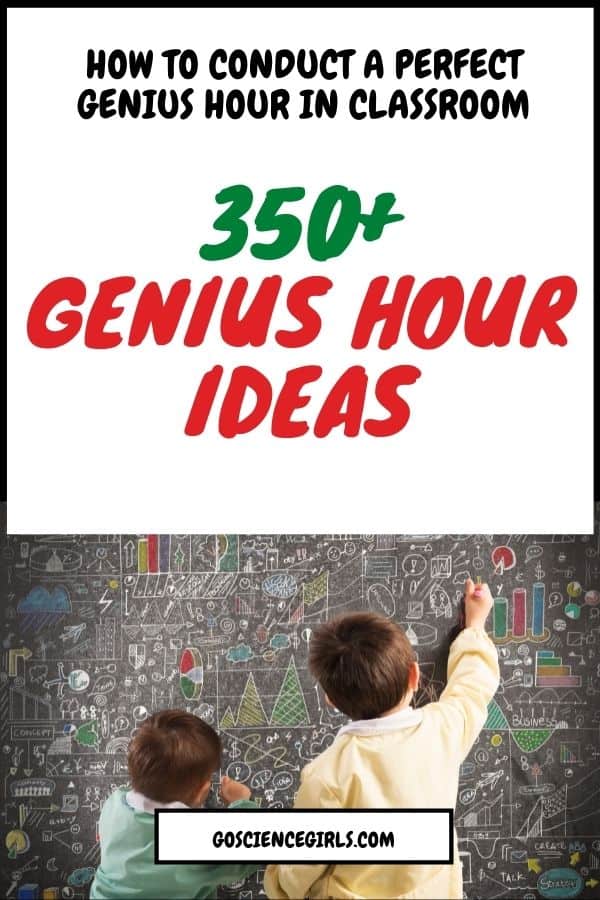
Leave a Reply Cancel Reply
Your email address will not be published. Required fields are marked *
Name *
Email *
Add Comment *
Save my name, email, and website in this browser for the next time I comment.
Post Comment
EdTech Classroom
How to Implement Genius Hour in Your Elementary School Classroom

In today’s blog post, I’ll be sharing step-by-step directions and strategies for implementing Genius Hour in your elementary classroom. If you teach older grades, I also share more broad strategies for K-12 and beyond in this previous post.
(1) First, I’ll describe Genius Hour and the purpose behind it.
(2) Then, we’ll take a look at some strategies on how to structure Genius Hour in your elementary classroom.
(3) I’ll provide some tips and tricks when it comes to grading and assessment.
(4) Lastly, I’ll share some additional resources if you would like to learn more!
If you are looking for a Genius Hour passion project planner to use with students, consider checking out this low-prep resource!
What is Genius Hour?
A number of years ago, many tech companies started doing this 80/20 idea in their workplaces where employees are allotted 20% of their work time to pursue on their own passion projects.
The only rule is that their projects have to benefit the company in some way. And what is really incredible about this 20% time is that employees have been able to create some pretty amazing, life-changing products.
And I’m not exaggerating here.
20% Time has proven to be wildly successful for companies…
Some of Google’s biggest products including Gmail and Google News came from Genius Hour projects.
In addition to creating new products, many employees are actually liking work more. When people spend time pursuing their passions, they are happier, they learn more, they contribute more. They innovate.
Genius Hour in Education
In the education field, many teachers have used Genius Hour with a similar premise: students can spend a certain amount of time (decided by either the teacher or school) to work on their own self-guided passion projects.
In a Genius Hour project, students have several weeks where they research topics of their choice and create final products to share with the community – either their school community or the community at large.
There is no magic formula or special recipe to implementing the perfect Genius Hour.
All teachers need to do is make sure they are focusing on two main things: passion and purpose.
Genius Hour works best when students feel deeply passionate about their project topics and when students actually feel like there is a purpose to their project and a real-world application.
Structure of Genius Hour
I want you to walk away from today’s blog post with a very clear plan on how to execute and implement Genius Hour in your elementary classroom. The best way to get started with Genius Hour is to follow a clear structure.
As the teacher, first, you’ll want to decide on a subject area.
Select a Subject Area
Before starting this project with your students, you need to decide whether you are aligning your Genius Hour with a specific standard or subject area.
For example…
- Do you want your students to explore a specific topic, like ecosystem science or nonfiction reading?
- Do you want your students to explore something more open-ended, like a topic they feel passionate about?
A science teacher might want to focus on a specific topic, like space or the food chain, whereas an ELA teacher might opt for students to explore more open-ended topics or subject areas based on their book groups. Alternatively, a STEM teacher might want students to build a solution to help achieve one of the Sustainable Development Goals.
For the purpose of this blog post, I’m going to select a general, non-subject area specific Genius Hour.
Five Key Pillars of Genius Hour
Once you have decided on a subject area, you can now start planning the project phases of Genius Hour. I’ll be referring to these phases as the five key pillars of Genius Hour.
- Students select their topics .
- Students formulate research questions .
- Students research topics .
- Students create projects .
- Students share their projects with the school or greater community.
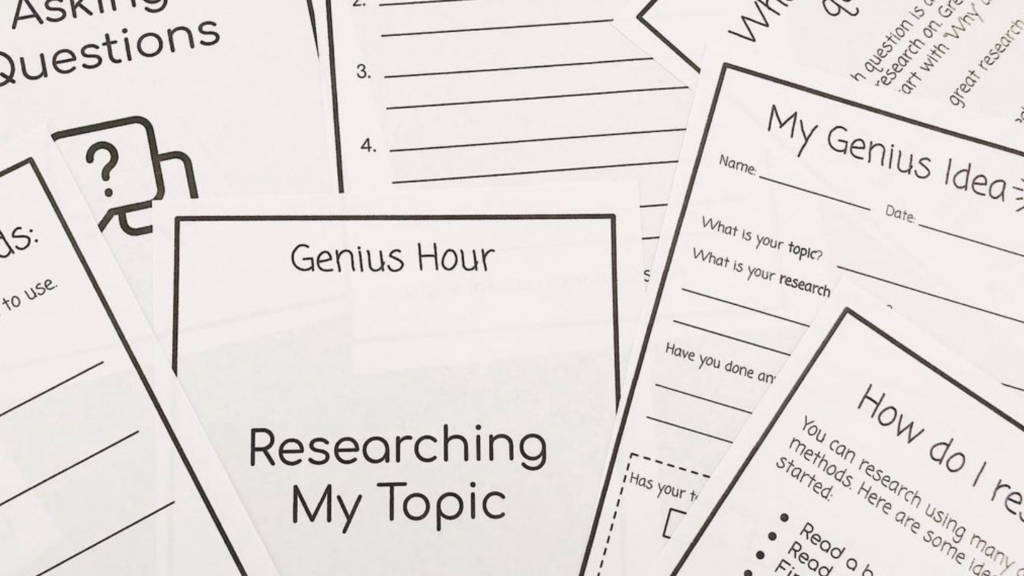
At the start of a Genius Hour unit, I always recommend sharing these five pillars with your students. It is so important for them to understand where they are going. In order to create their own goals and projects, they need to have a roadmap.
That’s where these five steps come in.
Here is a timeline that you can use (and adapt based on your classroom needs):
- Brainstorming topics: 2-3 days
- Formulate research questions: 4-5 days
- Research topics: 1-2 weeks
- Create projects: 1 week
- Share: 1-2 days
In my Genius Hour passion project planner , I break down this timeline clearly for teachers and students.
Step 1: Students select their topics
On the very first day of Genius Hour, I’d recommend (1) explaining what Genius Hour is to your students, and (2) breaking down these five steps. Depending on your classroom needs, you can also consider sending home a letter to families explaining what Genius Hour is.
The purpose of the first week is to guide students to select a meaningful topic that aligns with their interests.
To do this, you can begin by having students brainstorm things like:
- What are your strengths and stretches in school?
- What are your passions outside of school?
- What subjects are you interested in?
- What do you like to do for fun?
During the first week, you can also have students create “I wonder” pages, where they write or draw their wonderings.
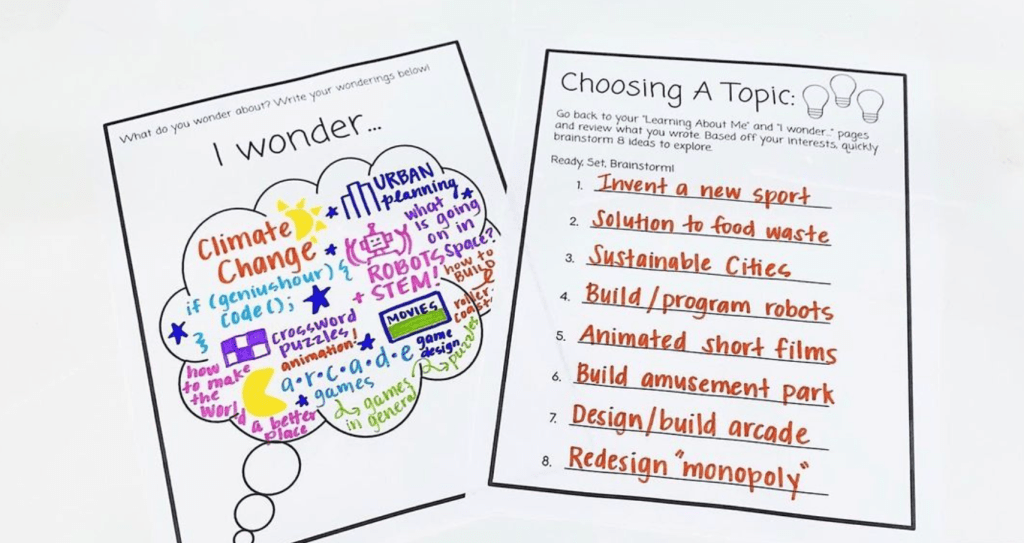
Once students have created their “I wonder” pages or begun their initial brainstorming, you can have them narrow down their choices to 3-8 different topic areas.
On the last day of the brainstorming phase, guide students in selecting their “genius idea!”
Step 2: Students write research questions
Developing research questions can be a bit tricky for many elementary students. For this stage, I’d recommend creating an anchor chart to help students learn about high-quality research questions.
To teach students about research questions, you can start off by saying something like…
“A research question is a question that you base your research on. Great research questions often start with ‘why’ and ‘how.’ Can anyone in the class come up with a question that might start with ‘why’ or ‘how?”

On your anchor chart, you can write down the question words “why” and “how.” You can also include questions that students share, or you can have some prepared to write down.
For example:
- How can we reduce food waste at our school?
- How do engineers design a fast, thrilling roller coaster?
You can also help students learn the different between questions that are too broad and too narrow. Students can learn about the importance of asking “just right” questions – questions that can’t be answered with a quick Google search but also aren’t too complex to answer.
When students are ready to write their questions, it might take them multiple tries. That’s okay! In fact, that’s great. Because of this, I’d recommend having a structure in place where you “approve” students’ research questions.
You can create this approval structure through one-on-one check-ins, worksheets to turn in, or even Google Forms that students can submit.
Step 3: Students research their topics
Once students have written their research questions, they can begin their research.
During this research stage, students can read non-fiction books. They can practice their digital citizenship skills by doing online research.
If you are struggling to figure out where to start, consider reaching out to your school librarian or taking a look at your grade level’s ELA standards related to research.
Other skills that students can practice include:
- Learning about different resources, like newspaper articles, books, and talking to experts.
- Note-taking.
- Distinguishing fact from fiction.
If you are looking for more guidance on how to introduce research to students, I share some helpful tips in my Genius Hour passion project planner.
Step 4: Students create their projects
In my experience, elementary students tend to have the most fun with this stage of Genius Hour: creating their projects. In this stage, students can really go wild with their imaginations and creativity.
This stage is FUN!
As the teacher, you can give students examples on how they might present their work to the class community. Some ideas might include:
- Short films
- Stop-motion animation
- TED-style talks
- Acting performance
During this stage, you can give students as much flexibility or structure as you feel makes the most sense for your class. At the end of the day, you know your students better than I do!
Give students choice but also give them guidance.
Step 5: Students share their projects
Most project-based learning units end with some sort of final presentation or public product. Genius Hour is the same.
Students can share their work with their class, the school, or the greater community. The scope of the presentation and audience is up to you.
Many students find joy in being able to share and present their work to their peers. Keep the sharing phase joyful.
Grading and Assessment
In my conversations with other teachers, I’ve found that assessment can be tricky. This is because with Genius Hour, it’s best to grade and assess process over product.
I recommend that you grade Genius Hour projects based on the 5 key pillars: brainstorming, writing questions, researching, creating and building, and sharing.
An “exceeds standards” in Genius Hour at the elementary level might look like:
- Brainstorming: Develops many creative and innovative ideas.
- Writing Research Questions: Writes strong, thought-provoking research questions.
- Researching: Is able to synthesize research and draw meaningful connections.
- Creating and Building: Always creates a prototype that they can explain.
- Sharing: Always is able to go above and beyond to share and reflect on a prototype in creative ways.
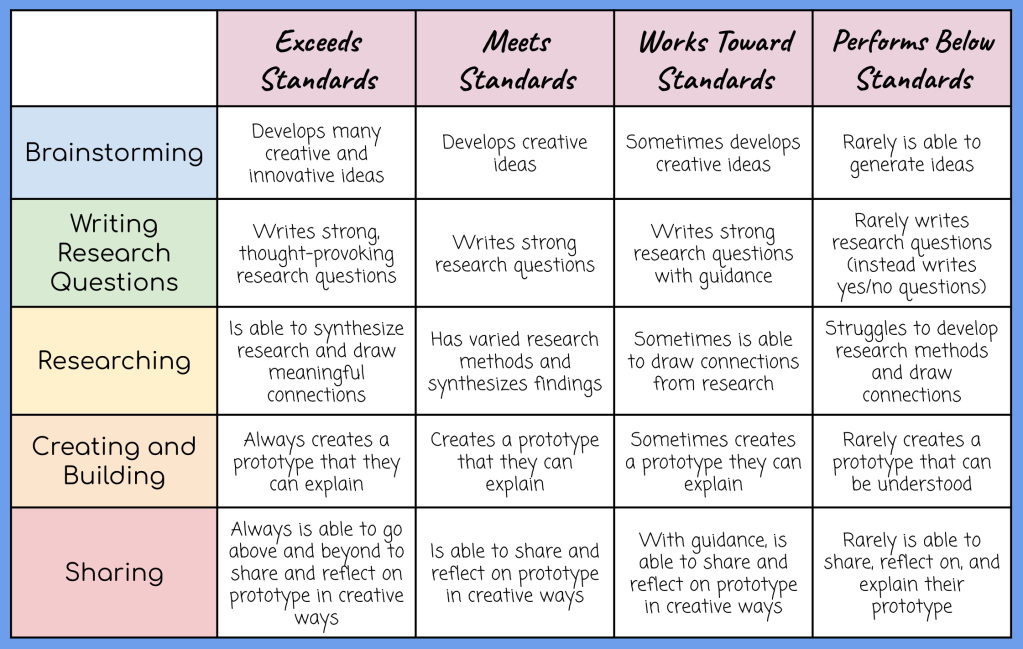
Of course, this is just a recommendation – feel free to adapt this rubric to meet your classroom needs or specific standards.
Additional Resources
As promised, here are some additional resources to help you get started with Genius Hour. Many of the following resources helped inspire this blog post:
- Genius Hour website: http://geniushour.com/
- A.J. Juliani’s blog posts on Genius Hour: http://ajjuliani.com/category/genius-hour/
- John Spencer’s blog posts and podcast episodes on Genius Hour: https://spencerauthor.com/tag/genius-hour/
- Cult of Pedagogy’s post on Genius Hour: https://www.cultofpedagogy.com/genius-hour-questions/
- We Are Teacher’s post on Genius Hour: https://www.weareteachers.com/what-is-genius-hour/
- My Genius Hour Passion Project Planner: https://www.teacherspayteachers.com/Product/Genius-Hour-Passion-Project-Lesson-Plan-Interactive-Notebook-5413549
I hope you found this guide on how to implement Genius Hour in your elementary classroom helpful. If you liked this post and end up trying out Genius Hour, please let me know how it goes. I’d LOVE to hear from you!
If you would like to use my Genius Hour passion project planner with your students, you can check it out here!
genius hour , pbl
Share this:
EdTech Classroom View All
2 thoughts on “ how to implement genius hour in your elementary school classroom ” leave a comment ›.
- Pingback: Bringing Blogging into the Classroom with Student Blog Projects – EdTech Classroom
- Pingback: A Case for Tinkering, Exploration, and Play for Every Grade Level – EdTech Classroom
Leave a comment Cancel Reply

- Already have a WordPress.com account? Log in now.
- Subscribe Subscribed
- Copy shortlink
- Report this content
- View post in Reader
- Manage subscriptions
- Collapse this bar

Simplify Genius Hour Planning & Implementation
This step-by-step guide for implementing Genius Hour in your classroom is designed to take the guess work out of getting started with Genius Hour . You will have everything you need to jump in with both feet including: lesson plans, teacher resources, and a student Genius Hour Journal. This will easily take the stress out of Genius Hour planning.
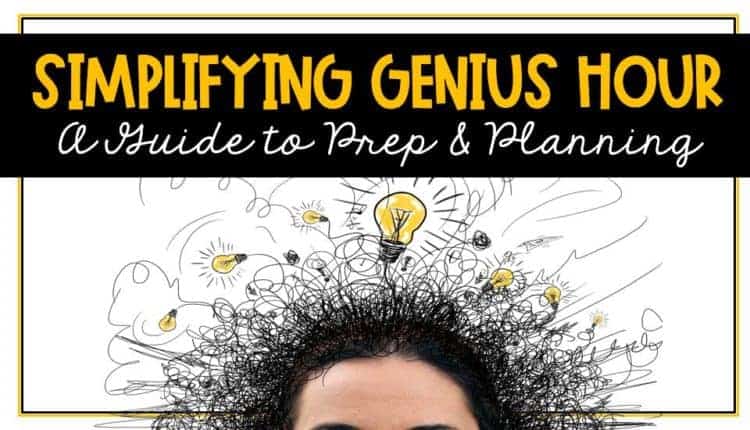
As I mentioned in my earlier post about the challenges of Genius Hour in the classroom, getting started can seem overwhelming because it requires handing over total control of the content to your students. The lessons and journal pages in this resource focus on overcoming that barrier by focusing on helping students develop genius hour projects that are both engaging and teach essential skills.
What’s included in this Genius Hour Planning resource?
This Genius Hour Planning Guide includes a number of resources for teachers to help organize and prepare to implement Genius Hour in the classroom.
Genius Hour Planning Resources for Teachers
Getting started with Genius Hour and keeping things on track can seem challenging when you are just starting out.
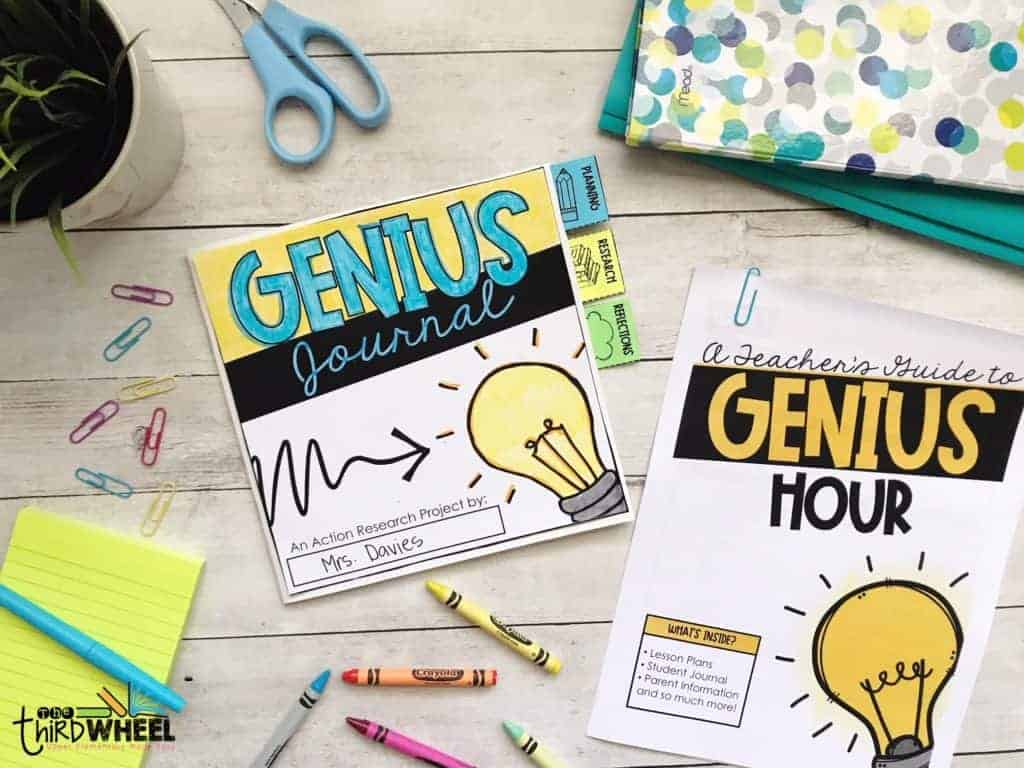
This resource includes a number of tools to help make this time go smoothly including:
- Genius Hour Information – a teacher resource to teach you more about what Genius Hour is and how to organize it in your classroom
- Question Tracker – record each student’s Genius Hour question to facilitate one-on-one conferences and resource acquisition
- Meeting Notes – document discussions and needs during one-on-one meetings about student’s genius hour projects
- Planning Organizer – make notes, create a to-do list, and record materials you’ll need to prepare each week
- Genius Hour Parent Letter – a pre-written letter to inform parents about Genius Hour and how it will look in your classroom
- Project Grading Rubric – a scoring rubric focused on the process vs. the product of Genius Hour
Genius Hour Lesson Overview and Lesson Plans
To help get you started, this Genius Hour planning guide gives you easy-to-follow lessons for introducing Genius Hour and helping students generate ideas for their Genius Hour projects. An overview document can help you get an idea of pacing, and it can easily be adjusted to meet the needs of your students.
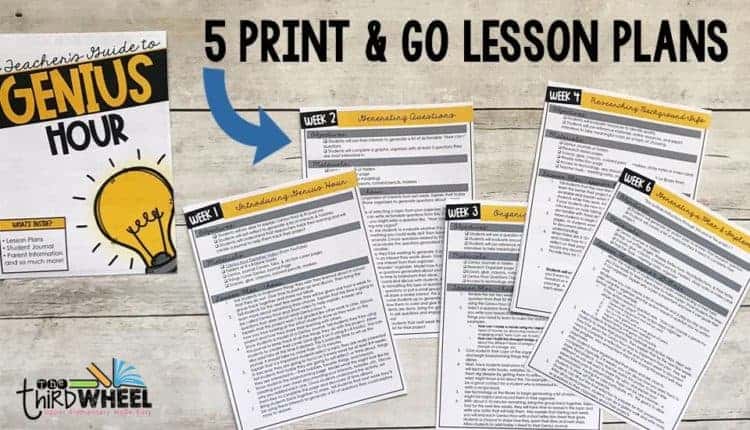
There are 5 lesson plans included in this pack:
- Introducing Genius Hour
- Generating Questions
- Organizing for Research
- Researching Background Info
- Making a Plan for Implementation
Each lesson plan clearly lays out student objectives, materials needed, and step-by-step plans. Each lesson is designed to take between 20-30 minutes with student work time interspersed throughout.
These lesson plans are designed to be used over the course of your student’s Genius Hour project to help transition between the phases of their work.
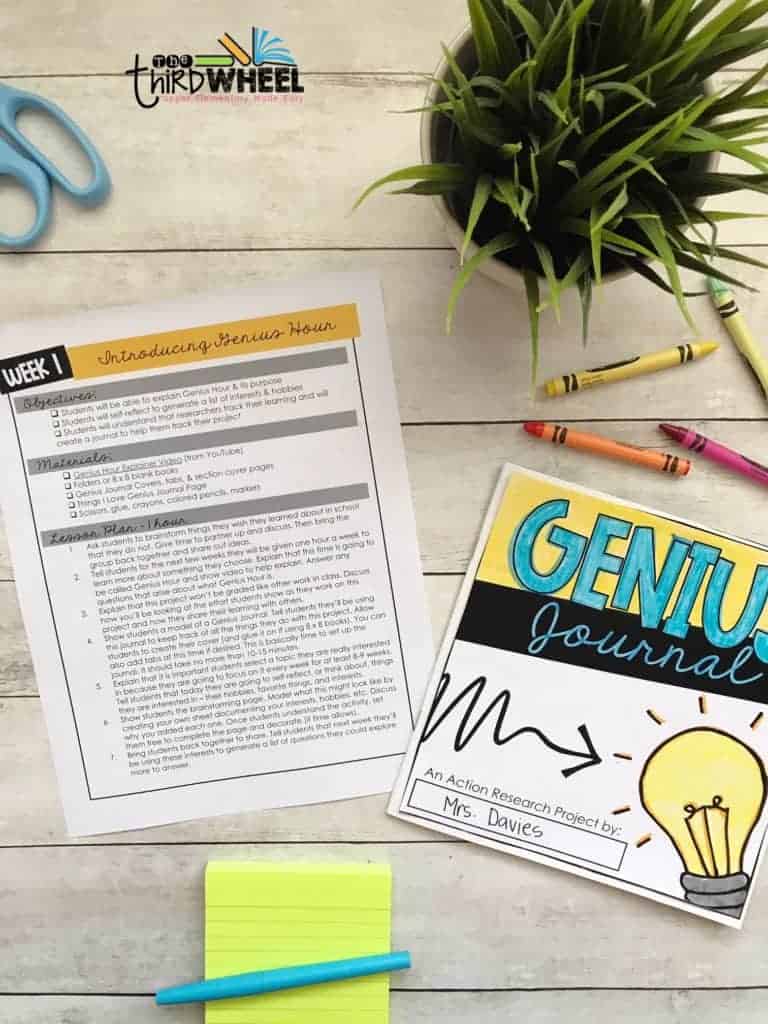
The first two lesson plans are the most important for helping students gather and develop a high-quality project that will hold their interest. The remaining plans focus on teaching mini-lessons to guide students on gathering background information, developing a plan of action, and implementing their plan.
There are student journal pages that coordinate with each of these phases of the project. They are listed in the materials needed for each lesson to make prep simple.
Genius Hour Journal for Students
The core of this pack is the Genius Hour Journal that students create while they work through the process. Each page is designed to guide students and document their progress toward answering their action research question. The journal can be glued into an 8 x 8 book – like those available in the Target Dollar Spot – or saved in a folder until the project is complete and stapled together.
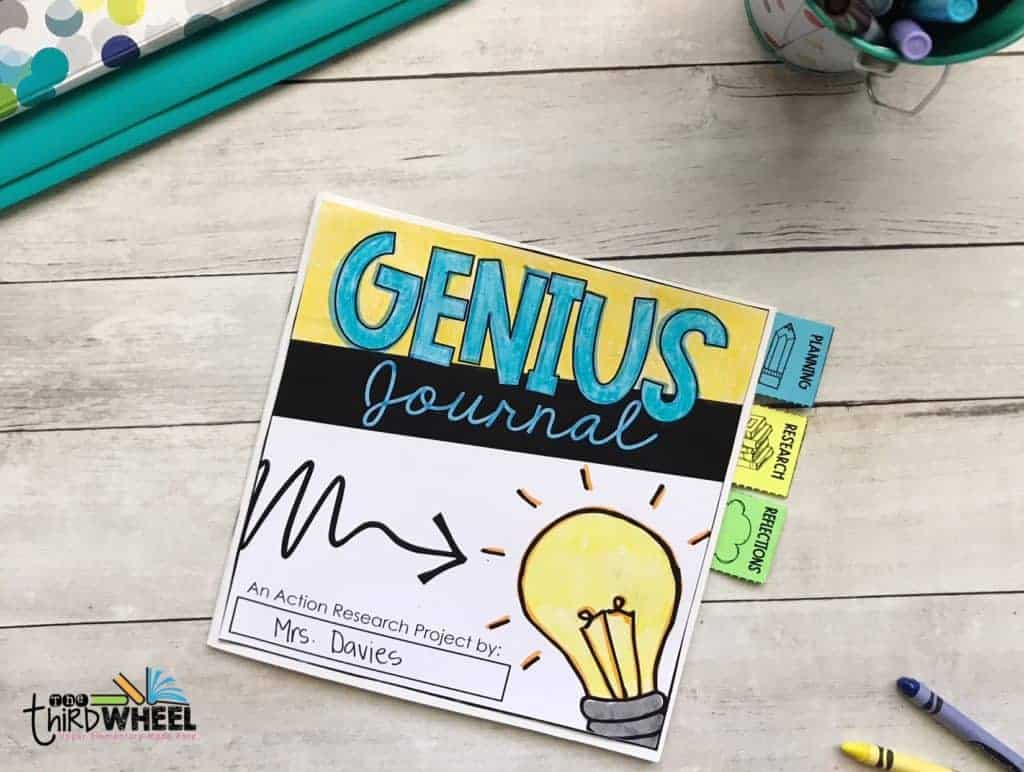
The set includes multiple cover options – including color and black & white versions. There are also tabs to separate the sections and section covers to help keep things looking neat and organized.
There are three sections to the student journal:
- Planning Tools
Here is a little more detail about each section and what it includes:
Genius Hour Journal: Student Planning Tools
This section is designed to help students identify a question for research and create a plan of action.
It focuses on moving students from a basic understanding of what Genius Hour is to having a cohesive action research question and a plan for how to answer it.
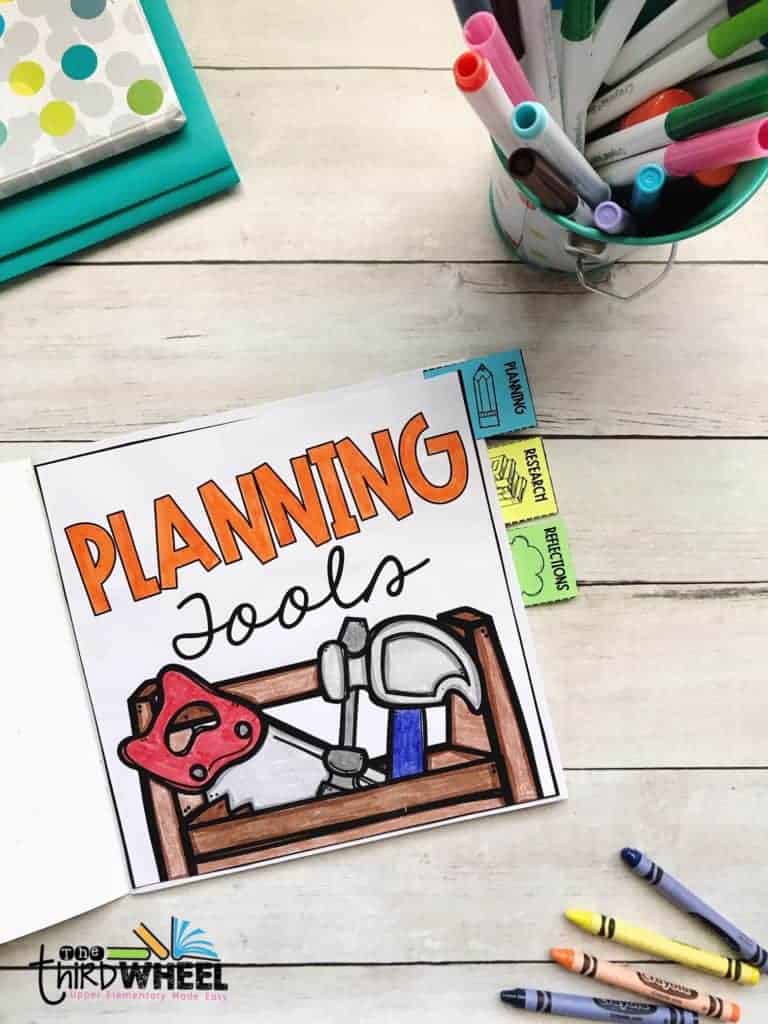
There are 5 types of pages in this section.
- Things I love
- Things I wonder
- Developing a research plan
- Mapping my action plan
- Implementation Notes
Here’s a bit more about each page.
1. Things I Love Journal Page
This first step has students identify their interests, hobbies, and passion. The coordinating journal page organizes these ideas so students can select topics to generate action research questions about.
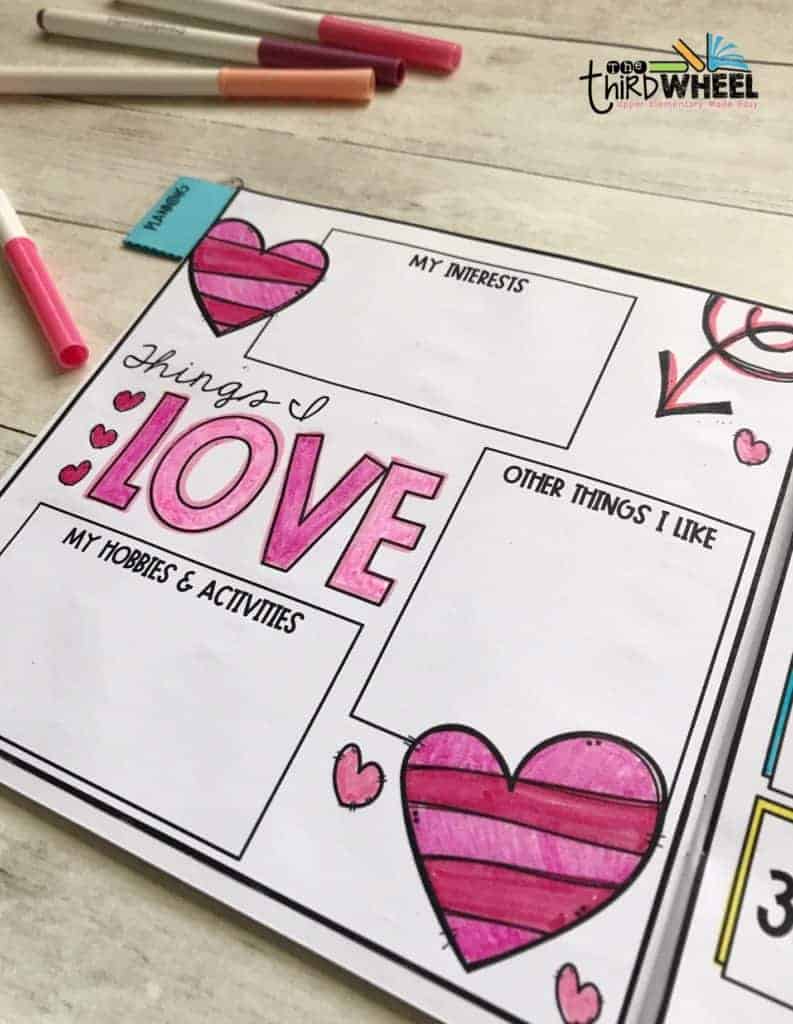
2. Things I Wonder Journal Page
This page is designed to have students take their interests and generate 3 actionable questions based on them. Through the use of the coordinating lesson plan, students also learn to write questions that focus on exploring their world through hands-on projects. Students are encouraged to write questions in the form of “How can I…?”
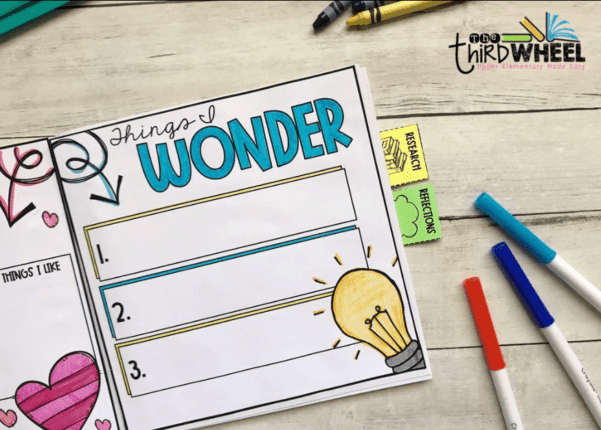
3. Developing a Research Plan Journal Page
This sheet is designed to help students determine what background information they need to complete their project effectively. First, students record their research questions and think about what information they might need to know. For example, if my plan was to make a movie, I might need to know how to write a script.
Finally, students record ways they could find the answers. This can include reference books available in the library, meeting with professionals in the field, and using technology to access information or videos.
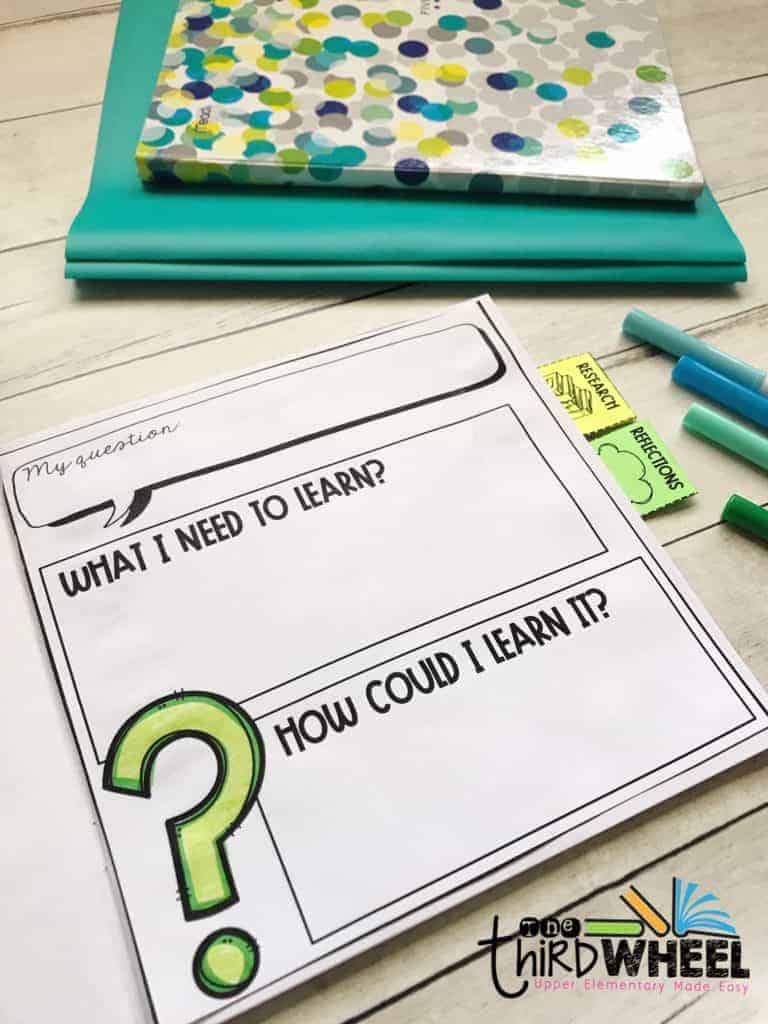
4. Mapping out a Plan Journal Page
This 2-page spread is completed after students research the information they needed from above. This guides them from the research phase to the action phase of the Genius Hour project. Students map out the specific project or experiment they will complete, the materials they will need, and the action steps needed to answer it.
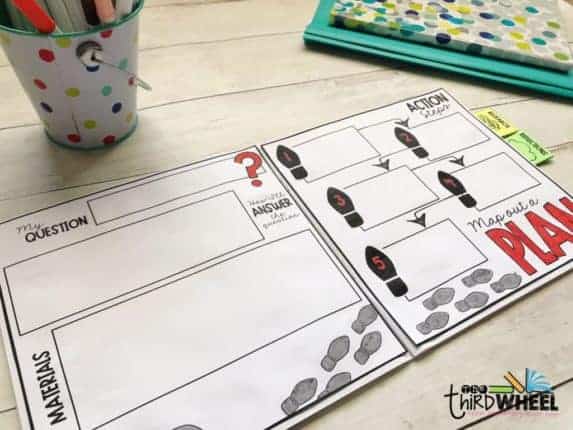
Genius Hour Journal: Student Research Notes
The research section of the journal is designed to allow students to keep track of their learning from various sources. Several formats of the notes page are included. In addition, there is a page to document references so that students can properly cite their sources.
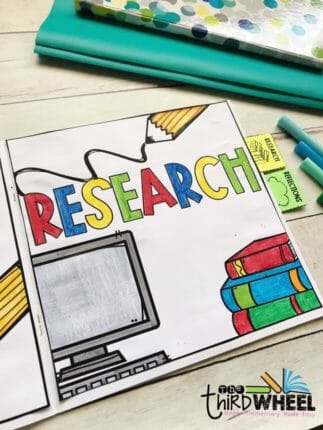
The research notes options include what I’ve:
- Learned through Observation
- Found Out from an Expert
- Discovered from Reading
- Learned Online
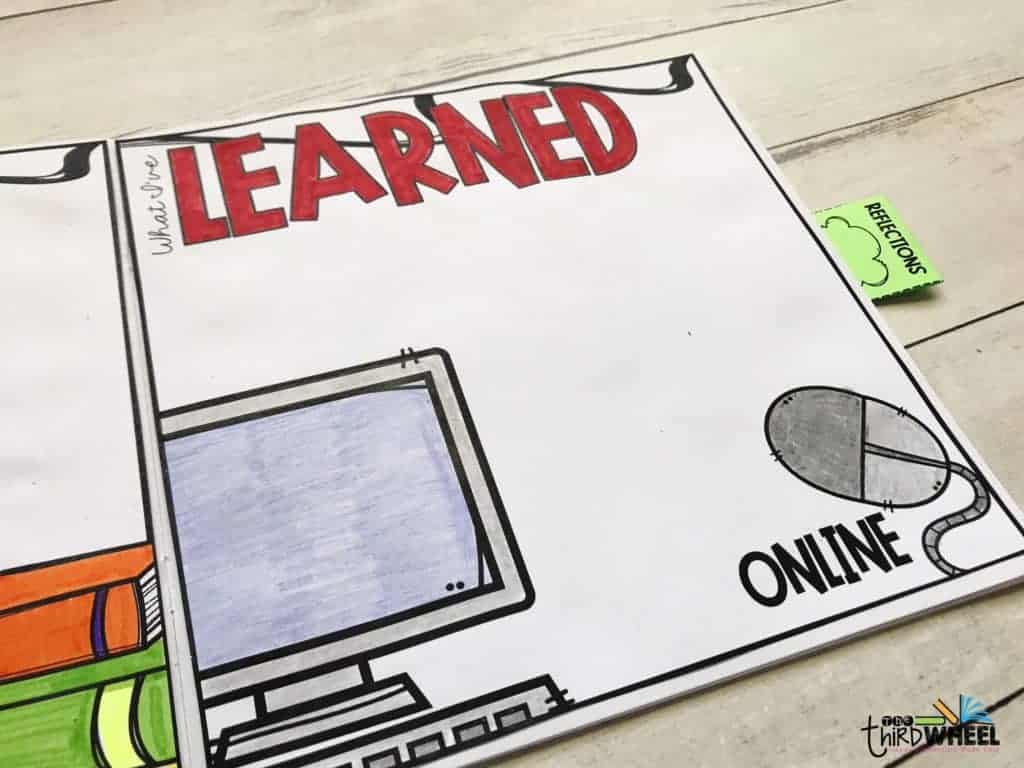
Genius Hour Journal: Student Reflections
There are three types of reflections included in the journal: weekly, final, and peer reflections. Here’s a little bit about each of these.
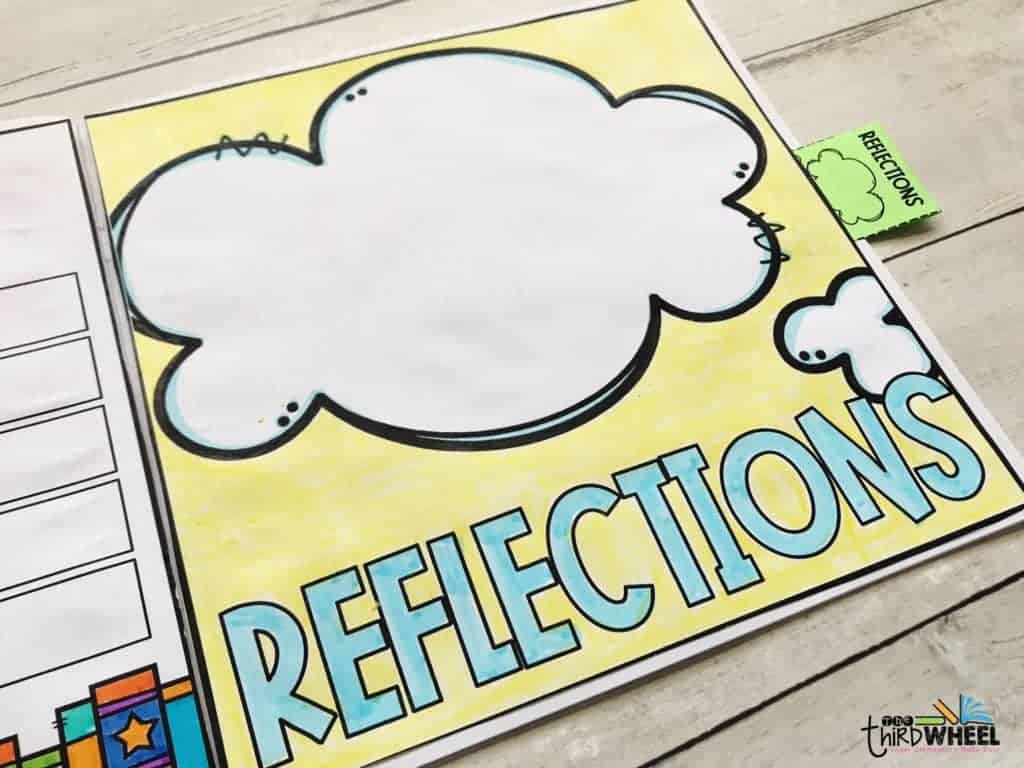
Weekly Genius Hour Reflections
There are two versions of this reflection sheet included in the pack to allow teachers the option to choose what is best for their class.
Once students enter the research phase of their project, they are working more independently. Each week they complete a reflection to help focus them on what they’ve learned and the next steps of the project. The reflections are labeled with the date. Then students write about what they worked on and learned during that day’s Genius Hour.
Finally, students record what their next steps will be and any materials they will need. This is helpful for them and for the teacher to review to help gather any materials necessary.
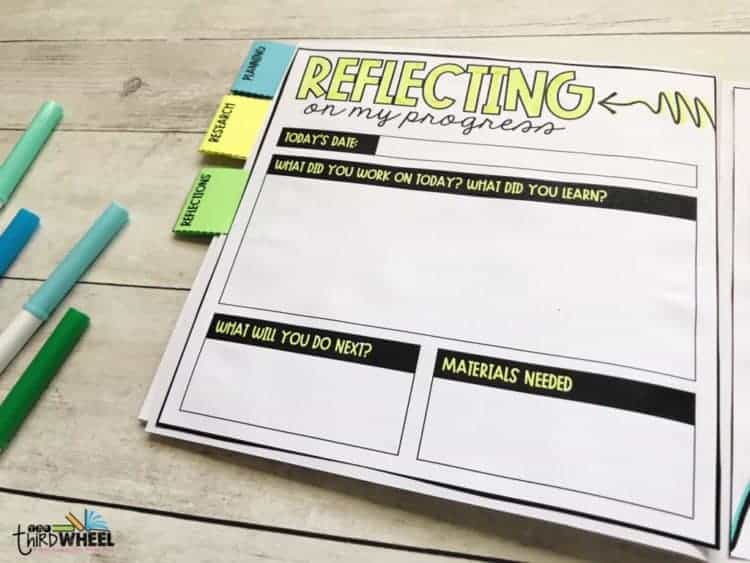
Final Genius Hour Reflections
At the end of the projects students complete this 2-page reflection to help them process their work over the last 8-9 weeks. This is designed to help them self-evaluate their project and consider projects they may want to take on in the future.
Students respond to several prompts including what went well, what was challenging, areas they continue to wonder about, and changes they would make to their project in the future.
There is also space on this page to make a “snapshot” sketch related to their project.
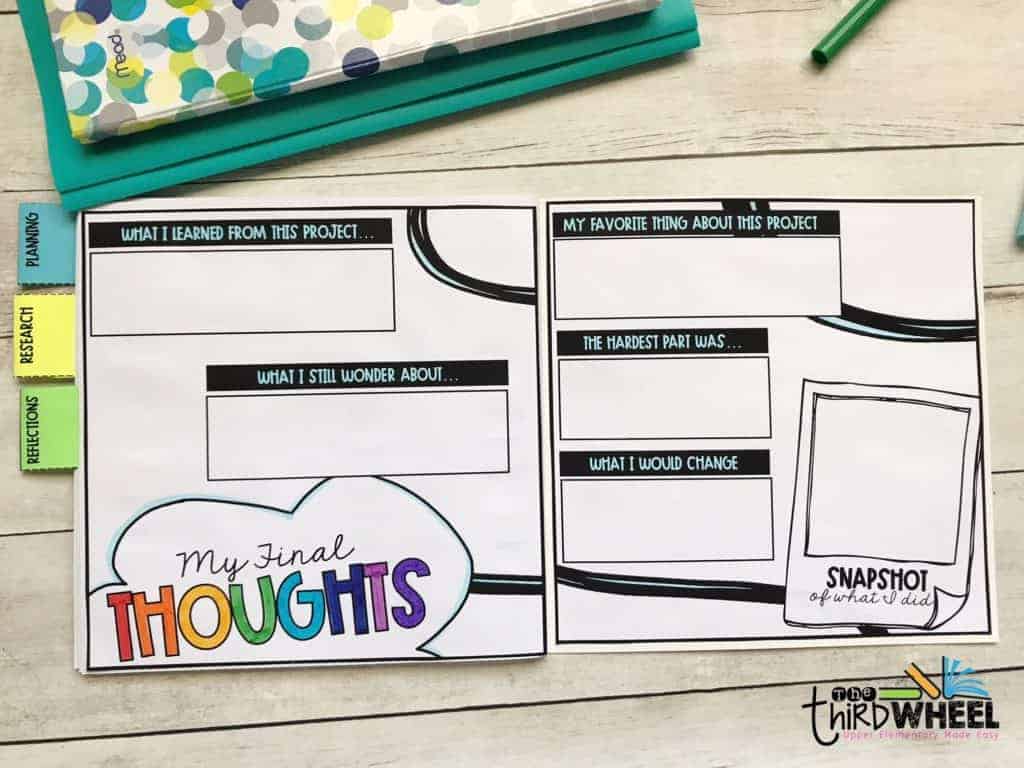
Peer Reflections
Two formats of the peer reflection pages are included in this pack. The first has peers write questions they have about the project for the student to review and answer. The second gives peers a space to write notes or observations about the project.
How to Purchase the Genius Hour Planning Guide
This Genius Hour Planning Guide has everything you need to get started with Genius Hour in your classroom. With lesson plans, a student journal, and teacher resources, you’ve got everything you need to help Genius Hour run smoothly.
You can purchase this Genius Hour resource on Teachers Pay Teachers.

Leave a comment Cancel reply
You must be logged in to post a comment.
- Grades 6-12
- School Leaders
Enter Today's Teacher Appreciation Giveaway!
What Is Genius Hour And How Can I Try It in My Classroom?
Self-directed learning builds skills and confidence. And it’s just plain fun!
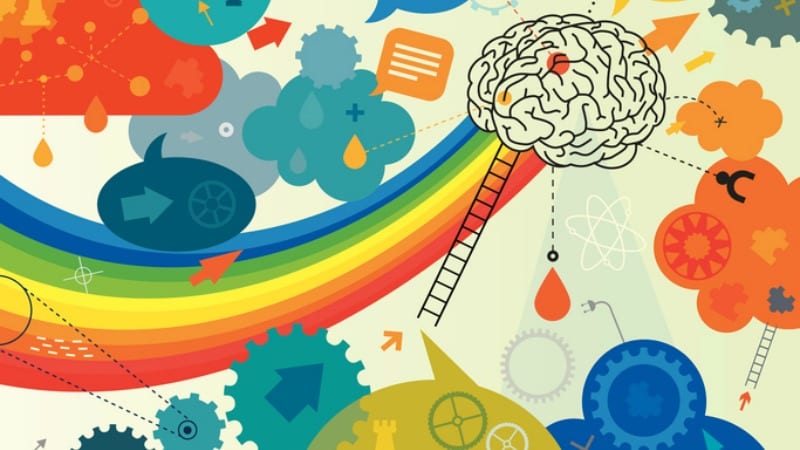
Whether you’re new to teaching or a seasoned veteran looking to keep up with the trends, you’ve probably heard the buzz about Genius Hour. Maybe you’re thinking about giving it a try but aren’t sure where to begin. WeAreTeachers has your back! Here are the basics to get you started.
What is Genius Hour?
https://www.instagram.com/p/BjAFjpIlwRz/?tagged=geniushour
Simply put, Genius Hour is inquiry-based, student-directed learning. Sometimes called Passion Pursuit, it gives students an opportunity to look at the big wide world around them and explore their own unique interests in a loosely structured, but supported, way. Terry Heick, founder and director of TeachThought , sings the praises of Genius Hour and describes it as a time when “students are in control; choosing what they study, how they study it, and what they produce or create as a result. As a learning model, it promotes inquiry, research, creativity, and self-directed learning.”
How do I fit Genius Hour into my curriculum?
https://www.instagram.com/p/Bi0gyH6HE4a/?tagged=geniushour
With all the demands on the precious little time we have with our students, you may be thinking, “Well, who’s got time for that?” We’re not talking about a huge investment of time or energy. Genius Hour simply allows teachers to provide students a choice in what they learn and how they learn it during a set period of time within a school day or week. Some teachers allot one class period or one hour per week. Others aim for the 80/20 rule, in which 80 percent of the time is traditional standards-based teaching and learning and 20 percent is student directed.
What are the benefits of Genius Hour?
https://www.instagram.com/p/BilIDclHk2r/
Not only does Genius Hour create a pathway for intrinsic motivation, it encourages creativity. Generating questions and diving deeply into topics they are passionate about sets students up to be curious lifelong learners. In addition, the workshop style of Genius Hour builds students’ social skills and confidence. It encourages collaboration as students draw on their personal strengths and swap expertise, acting as “consultants” for one another.
What is my role during Genius Hour?
https://www.instagram.com/p/BiiruYGnHD2/?tagged=geniushour
In addition to creating the framework and setting the ground rules for Genius Hour in your classroom, your role is to help your students focus and problem solve. You learn alongside them as you coach them, conference with them, and help them reflect as they go through the process.
How do I keep Genius Hour from turning into a free-for-all?
https://www.instagram.com/p/BiZWPpPHaZ6/?tagged=geniushour
There are a few basic guidelines for implementing a productive Genius Hour. Veteran teacher Jennifer Gonzalez, in her blog Cult of Pedagogy , suggests breaking the process down into steps. From planning and topic selection to research, presentation, and reflection, giving your students a basic framework for their work makes Genius Hour a manageable project.
Here is a sample pathway:
1. Pick a topic.
Brainstorming ideas and narrowing down options can sometimes be the trickiest part of the process for students. Guide them to choose a topic that they are truly passionate about and is just the right size.
2. Develop a driving question.
Once your students pick a topic, they will need a driving question to guide their research. This is the what, why, and how that allows them to go deeper into their subject. If the question they are asking can be answered with a simple Google search, it is not specific enough. A great place to start for guiding students through the inquiry process is this infographic from TeachThought.
3. Do the research.
There are many ways for students to dig up information on their chosen topic. In addition to reading books and articles, students can access websites, watch videos, and connect with experts in the community. Have your students use note catchers, write in their journals, or blog to stay organized and be accountable for their research. However, don’t get bogged down on this step. Teacher AJ Juliani cautions, “ You don’t want to spend too much time in the research phase, because you really want to get into the making, creating, [and] designing phase and start building your project into a reality.”
4. Bring it all together.
Creating something original is the core purpose of Genius Hour. Whether students publish, design, act, make, or do, there should always be a tangible takeaway from the process. How your students choose to present what they have learned is limited only by their imagination. Some ideas? Create a blog, shoot a video, write and perform a play, or paint a mural. Put on a puppet show, set up a gallery walk or wax museum. Make it a big deal by inviting families and community members to presentation day.
5. Reflect.
After the presentation, bring the process full circle and “cement the learning” by asking your students to reflect. What went well? What did you learn? What would you do differently? Where do you want to go from here?
Learn More about Genius Hour.
- Genius Hour: Passion Projects that Ignite Innovation and Student Inquiry by Andi McNair
- The Genius Hour Guidebook: Fostering Passion, Wonder and Inquiry in the Classroom by Denise Krebs and Gallit Zvi
- Launch: Using Design Thinking to Boost Creativity and Bring Out the Maker in Every Student by John Spencer and A.J. Juliani
- Genius Hour: Unlock Your Inner Genius
- What is Genius Hour? Introduction to Genius Hour in the Classroom
- Genius Hour Introduction for Kids
- What is Genius Hour? An Overview of Genius Hour and 20% Time in the Classroom
Have you tried Genius Hour in your classroom? We’d love to hear about it in our WeAreTeachers HELPLINE group on Facebook.
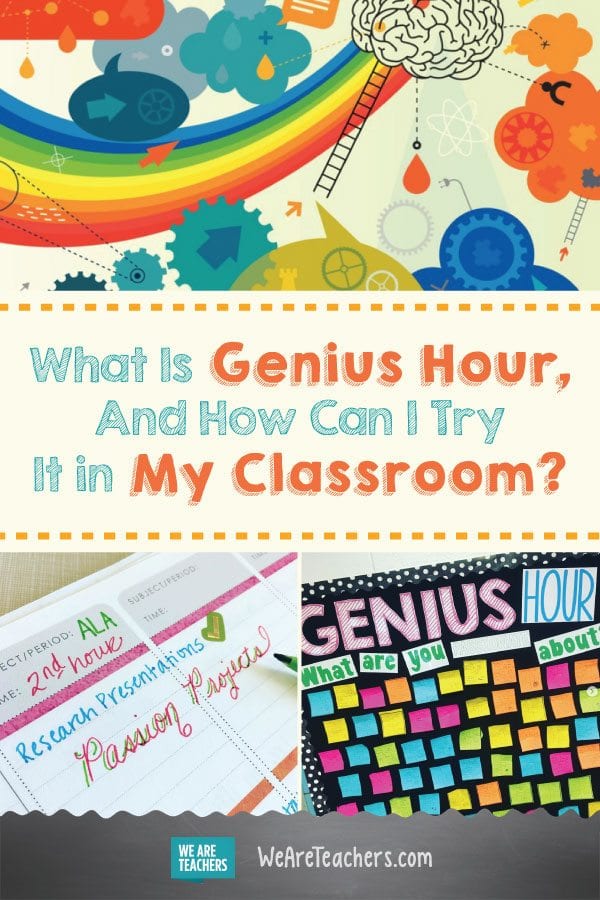
You Might Also Like

100 Unexpected Last-Day-of-School Activities Your Students Will Love
Send them off for summer with a smile! Continue Reading
Copyright © 2024. All rights reserved. 5335 Gate Parkway, Jacksonville, FL 32256
Let's Collaborate! Blog

Welcome to Genius Hour
October 27, 2015
by Genius Hour Guide · Published October 27, 2015 · Last modified August 28, 2018
Celebrating Passion, Wonder & Inquiry
Here at the Genius Hour Guidebook website, you’ll find many resources from the book by Denise Krebs & Gallit Zvi, plus bonus articles and materials. Best of all, you’ll be able to engage with colleagues eager to support each other as we implement Genius Hour in our classrooms and schools. Read our welcome message!

The Genius Hour Guidebook
November 4, 2020
by Denise Krebs · Published November 4, 2020 · Last modified November 7, 2020
Heart Mapping Resources for November Chat
Today our chat was an interactive session, where we created heart maps and then added our heartbreaks. We considered what we could do about the heartbreaks. Then we discussed how we could use heart maps...

#Geniushour Chat Archive
September 4, 2020
by Denise Krebs · Published September 4, 2020
Geniushour Chat Archive with Kristin Koppers
It was great to have Kristen Koppers (@Mrs_Koppers) as the guest moderator of the September 2020 chat. Kristen is the author of Differentiated Instruction in the Teaching Profession: Innovative ways to change how we...

August 7, 2020
by Denise Krebs · Published August 7, 2020
Genius Hour Chat Archive with Ryan McGinnis August 2020
Today’s chat was led by Ryan McGinnis, from Pennsylvania. He is a Tech Integrator with @CABOCESit. Ryan asked some interesting questions that were discussed by Sheri Edwards, Jill McLean, Kara at ContextEDU, Andi McNair, Gallit...

Book Resources / Other Genius Hour Resources
May 27, 2020
by Denise Krebs · Published May 27, 2020 · Last modified May 30, 2020
“6 Steps for Genius Hour” Chat Summary from GHVS
Gallit Zvi and Denise Krebs led a session on the 6 Steps for Genius Hour at the Genius Hour Virtual Summit held on 12 May 2020. We recently took time to read through the chat...

May 23, 2020
by Denise Krebs · Published May 23, 2020
Genius Hour Chat Archive with Joy Kirr May 2020
At our May chat we talked about how to help our students get the most of Genius Hour experiences at home. Joy Kirr led us in these questions: Q1 In your opinion, how does #geniushourathome...

Denise Krebs / Other Genius Hour Resources
May 11, 2020
by Denise Krebs · Published May 11, 2020 · Last modified May 28, 2020
Genius Hour Virtual Summit
Want to learn more about Genius Hour? Join us THIS TUESDAY, 12 May 2020, for the FREE Genius Hour Virtual Summit. Come to one or all sessions. Andi McNair, Gallit Zvi, Denise Krebs, A.J. Juliani,...
#Geniushour Chat Archive / 6 Steps Sketchnote / Book Resources / GH Proposal Form / GH Self-Assessment Acrostic / The Genius Hour Guidebook
April 3, 2020
by Denise Krebs · Published April 3, 2020
Genius Hour Chat Archive – 6 Steps for Genius Hour Done Virtually
Tonight Gallit (@Gallit_Z) and Denise (@mrsdkrebs) led the #geniushour chat. The topic was how to do the steps of genius hour at home with students instead of in the classroom. At this time of sheltering...

March 6, 2020
by Denise Krebs · Published March 6, 2020 · Last modified April 3, 2020
Genius Hour Chat Archive with Dave Quinn – March 2020
Many thanks to Dave Quinn (@EduQuinn) for a great chat this evening about the role of the teacher during Genius Hour. Our TweetDeck Collection archive for the March 2020 #geniushour chat: March 2020 Genius Hour...

February 7, 2020
by Denise Krebs · Published February 7, 2020
#Geniushour Chat Archive with Andi McNair, February 2020
Tonight’s Genius Hour chat was a great discussion about how Social-Emotional Learning connects with Genius Hour. Thanks to Andi McNair (@mcnairan3) who led us in the discussion. We saw some new faces and veterans at...

December 6, 2019
by Denise Krebs · Published December 6, 2019 · Last modified December 14, 2019
Genius Hour Chat Archive with Paul Solarz – 5 December 2019
Paul Solarz (@PaulSolarz), author of Learn Like a Pirate, led us in a lively discussion tonight. His questions had us comparing Project Based Learning and the learning that occurs in Genius Hour. The questions and...
New Second Edition is Out

- Recent Posts
- Popular Posts
- Recent Comments

Win a Free Book
Read a Post, Leave a Comment, Win a Book!

Book Resources / Creativity Rubric
Use This Genius Hour Creativity Rubric with Your Students
Frequently Asked Questions / GH Articles
Some Sample FAQs from the Genius Hour Guidebook

GH Articles / Sharing Ideas
Share Your Genius (Hour) Ideas for the Coming School Year!

Genius Hour Videos / GH Articles
Videos That Genius Hour Teachers Love
Sign Up for the Genius Hour Guidebook newsletter!
Email address:
Research to Practice: Implementing Genius Projects in the Middle Grades
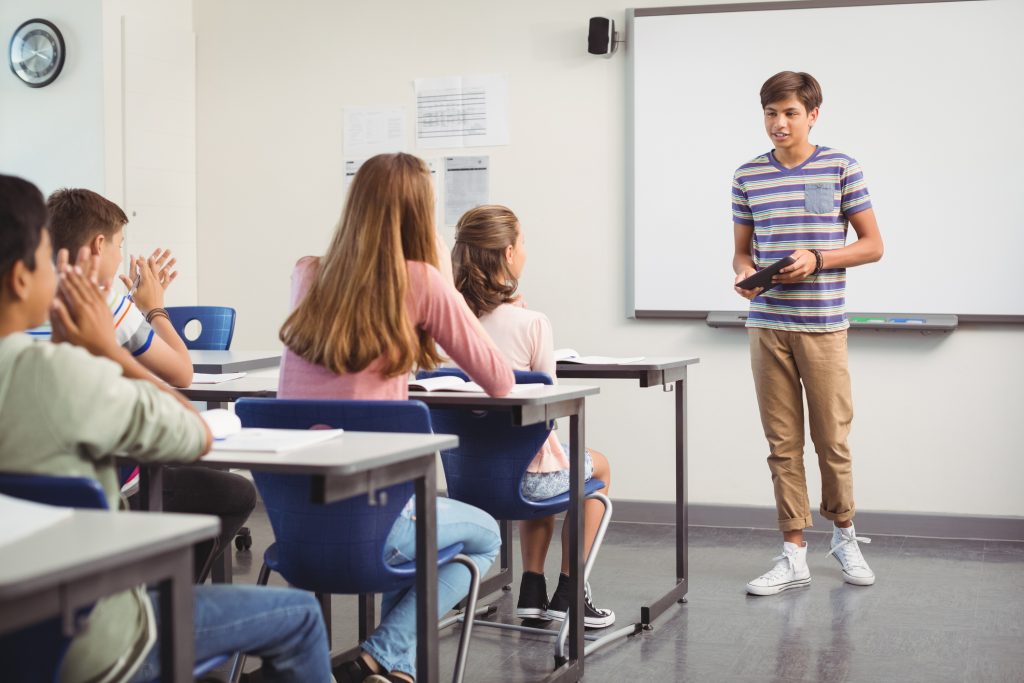
By: David C. Virtue
A genius project—also called genius hour (Davis, 2022; Mulvahill, 2018), enigma mission (George Lucas Educational Foundation, 2019), or passion project (Bowersox, 2020; Wormeli, 2018)—is a form of personalized learning in which students engage in sustained, self-directed inquiry for part of the school day. Genius projects are a natural fit for the middle grades because they promote active, purposeful, democratic learning and a curriculum that is “is challenging, exploratory, integrative, and diverse,” as recommended by The Successful Middle School: This We Believe (Bishop & Harrison, 2021, p. 32).
While genius projects may take many forms, they generally share some common characteristics.
- Genius projects involve deep personalization of learning as students choose the focus for the inquiry based on individual interests, expertise, and curiosity (Bishop et al., 2019; Davis, 2022).
- Students manage their own learning throughout a genius project by setting goals, establishing work plans, determining the format for final products, and evaluating their own performance (Bishop et al., 2019).
- Teachers have a facilitating role during genius projects, acting as an instructional coach or guide (Flood, 2019).
- Genius projects exhibit the three fundamental tenets of authentic achievement: students (a) construct original knowledge, (b) apply academic knowledge and skills through disciplined inquiry, and (c) share the final product of their inquiry through a public demonstration, performance, or exhibition (Newmann & Wehlage, 1993).
While genius projects have grown in popularity in recent years, few research studies have investigated their implementation and impact in middle level schools. A recent study published in Research in Middle Level Education Online reports teachers’ perceptions of the implementation of genius hour in their school and provides some useful insights for middle level schools considering this innovative approach (LeGeros et al., 2022). This article shares some key insights from the study to help middle grades educators further explore ways to incorporate genius projects in the academic programs in their schools.
Teachers Find Genius Hour Supports Personalization
LeGeros and colleagues (2022) explored teachers’ perceptions of the implementation of a school-wide genius hour in a school that had been aiming to strengthen personalization in the academic program. The qualitative case study drew on interviews with 17 teachers and one administrator during a period that spanned four years. The study focused on three questions:
- How did teachers perceive the school-wide genius hour to affect student engagement and learning?
- How did teachers describe their experience with the school-wide genius hour as a collective endeavor?
- What did teachers learn from genius hour in relation to their pedagogy? (Legeros et al., 2022, p. 2)
Regarding the first question, teachers interviewed for the study reported that genius hour supported student learning and engagement in several ways. Because genius hour afforded students choice and voice in their learning, teachers perceived them to be highly engaged in the learning process. Students were invited “to assume control over most aspects of their projects, including the topic, the learning process, the end product, and the sharing process” (LeGeros et al., 2022, p. 9). Furthermore, students developed self-directed learning skills, which some teachers saw them apply in the classroom beyond genius hour. Teachers also ascribed increased student engagement to the genuine relationships forged as they became more deeply and authentically aware of students’ interests, talents, and capabilities.
In response to the second research question, teachers reported that genius hour provided a powerful model for personalization and helped strengthen the sense of community in the school. The school was in a state that had mandated personalized learning in the middle grades, yet the teachers found a “paucity of existing models [depicting what] personalization should look like in practice” (LeGeros et al., 2022, pp. 10–11). The successful experience with genius hour helped fill teachers’ gaps in understanding about personalization and provided “a visible model” to guide future efforts (p. 11). Because genius hour was a school-wide initiative, it gave teachers throughout the school an opportunity to experience a collective success with personalization and supported the sense of community.
Finally, the researchers were interested in learning how teachers bridged the learning during the genius hour period with the practices in the regular classroom. How did the teachers’ positive experiences with personalization and greater student voice and choice transform their day-to-day classroom practices? While teachers enthusiastically acknowledged the positive outcomes of genius hour for students, they also wondered whether it could or should represent the norm for all classroom instruction. Teachers noted the limitations of the mandated curriculum as a constraining factor, and they also tended to feel students should not only pursue projects or subject matter that interest them; they should experience a broad curriculum that exposes them to various ways of knowing and seeing the world.
Considerations for Implementing Genius Projects
Although it focused strictly on teachers’ perceptions of genius hour, the LeGeros et al. (2022) study offers some important general considerations for implementing a genius project program.
- Design the program with broad input from stakeholders. The program in the study was designed by a leadership team consisting of administrators, teachers, students, and a university-based consultant, and throughout its implementation it was refined by an ad hoc committee and supported by regular meetings of teaching teams and a student leadership group.
- While genius projects can be implemented by a single teacher in one classroom, consider having a school-wide program as described in the study. The school-wide approach allows teachers to work and form relationships with students across teams and grade levels and may strengthen culture and community in the school.
- Consider making a multi-year commitment to the program. The study chronicled the implementation of genius hour over the course of four school years and showed how the program evolved over time. Some schools allow students’ genius projects to continue across multiple school years, allowing for deep, sustained learning (see, e.g., George Lucas Foundation, 2019).
- Look for ways to help students transfer the self-directed learning skills they develop during the genius project program into the regular academic program.
David C. Virtue is the Taft B. Botner Professor of Middle Grades Education at Western Carolina University and the editor of Research in Middle Level Education Online .
- Bishop, P. A., Downes, J. M., & Farber, K. (2019). Personalized learning in the middle grades. Harvard Education Press.
- Bishop, P. A., & Harrison, L. M. (2021). The successful middle school: This we believe . Association for Middle Level Education.
- Bowersox, M. (2020). Passion Projects Fuel Student-Driven Learning. https://www.ascd.org/el/articles/passion-projects-fuel-student-driven-learning
- Davis, V. (2022). Using Genius Hour Projects to Help Students Find Meaning. https://www.edutopia.org/article/using-genius-hour-projects-help-students-find-meaning
- Flood, K. (2019). Lawrence Public Schools – Instructors as “the Guide on the Ride”: Implementing Genius Hour and Focusing on Student-Driven Learning. http://www.nysed.gov/edtech/lawrence-public-schools-instructors-guide-ride-implementing-genius-hour-and-focusing-student
- George Lucas Educational Foundation. (2019). Passion-Driven Research Projects. https://www.edutopia.org/video/passion-driven-research-projects
- LeGeros, L., Bishop, P., Netcoh, S., & Downes, J. (2022). Informing the implementation of personalized learning in the middle grades through a school-wide Genius Hour. Research in Middle Level Education Online, 45 (1), 1–22, DOI: 10.1080/19404476.2022.2009707.
- Mulvahill, M. (2018). What Is Genius Hour and How Can I Try It in My Classroom? https://www.weareteachers.com/what-is-genius-hour/
- Newmann, F. M., & Wehlage, G. G. (1993). Five standards of authentic instruction. Educational Leadership, 50 (7), 8 – 12. https://www.ascd.org/el/articles/five-standards-of-authentic-instruction
- Wormeli, R. (2018). Fair isn’t always equal (2nd ed.). Stenhouse.
This sounds a lot like the capstones I got to do in my honors undergraduate program. It was really enjoyable for me to get to research and study something that I was passionate about. I think the Genius projects are a great way for students to take point in their own education.
Privacy Overview
Our range of over 180 online courses are fully accredited, trusted by more than 3 million learners and ideal for training you and your team.
- Food Hygiene
- Health and Safety
- Safeguarding
- Asbestos Awareness
- Fire Safety
- Mental Health
- Health and Social Care
- Business Essentials
- Team training

Welcome to the Hub, the company blog from High Speed Training.
Select a topic to find the most up to date, practical information and resources produced by our experts to support you in your professional life.
- Health & Safety
Ideas for Genius Hour in the Classroom
It is always important to find ways to make learning exciting, as well as giving students opportunities to explore their own passions and demonstrate creativity. As an educator, you can do this using innovative practices such as genius hour.
In this article, we will outline what genius hour means, why you should think about introducing it to your students, and how you could use it in your classroom.

What is Genius Hour?
Genius hour (sometimes called ‘passion pursuit’) is a student-centred practice that allows pupils to choose what they learn during a set period of time at school. Teachers often choose to implement it for one hour per week, and it could amount to around 20% of class time per year.
The concept of genius hour was popularised by companies such as Google, which allow employees to spend 20% of their time working on a project that they personally want to do. Giving people the chance to work on something that interests them was found to increase their productivity in general. In the classroom, the principles are the same – genius hour lets students explore their interests without being restricted.
There are no set rules for genius hour, but it can be helpful to provide students with some sort of structure. This supports them to stay on track and come up with a really interesting project, rather than squandering the time each week. Teachers might do this by helping their class to brainstorm ideas, giving them a project proposal form to fill out, or setting a basic timeline for the process. After the completion of a project, students might be given reflection journals to fill in, detailing what they learnt.

Why Should I Use Genius Hour?
There are a range of advantages to introducing genius hour in your classroom, including:
- Allowing students to explore their own unique interests in a way that traditional schooling does not. Genius hour makes learning more exciting and gives students ownership of their education – it thus increases their intrinsic motivation and autonomy, helping them to become lifelong learners. Through genius hour projects, they might discover hidden skills or interests that they didn’t know they had; this might influence what they choose to do in the future.
- Encouraging creativity . Rather than being passive learners, genius hour lets students generate their own ideas and think about how to explore them. This may come in useful later on, when they need to create and carry out work projects in their adult lives – in today’s world of work, soft skills like creativity and curiosity are critical.
- Fostering critical thinking and research skills . The research aspect of genius hour ensures that students develop their skills in finding relevant, reliable sources and evaluating the information given by them.
- Building social skills and confidence . Genius hour sessions are more like workshops, which encourage collaboration between students when they need help or want to share their ideas. This increases their social skills and confidence levels in the classroom.
- Developing metacognitive abilities . Through planning, monitoring, evaluating, and making changes to their own learning, students build their metacognitive skills. These skills are key to effective learning, as we discussed in this article .
The potential benefits make genius hour an invaluable idea to implement in the classroom.


Need a Course?
Build on your existing knowledge or learn new skills to help you in the classroom with our CPD Courses for Teaching Staff . Find everything from Challenging Behaviour to Mental Health Training For Teachers .
How Can I Try Genius Hour in My Classroom?
In this section, we will provide you with answers to common questions about trying genius hour in your classroom.
How Can I Make Time for Genius Hour & Does It Fit into the Curriculum?
If you are thinking about trying genius hour in your classroom, the first thing you might be considering is how to make time for it. The relatively little time you have with your class might make one hour seem like too much to give up, particularly if the hour will be spent on a topic that is unrelated to the curriculum. You could solve this problem by making genius hour related to what you’re currently teaching – create a generic lesson objective that ties in with the curriculum, and let students explore it as they wish. Their findings might give you a different perspective on the topic, as well as making it more memorable for them.

What is the Role of the Teacher in Genius Hour?
During genius hour, teachers are facilitators. You will need to provide the framework for genius hour that prevents it from turning into a ‘free-for-all’ – for example, by ensuring that they fill out a project proposal form, and giving them a deadline for completing and presenting their work. You should also give them ground rules to help them stay focused – though this type of lesson is inherently more casual, general rules such as keeping the noise level down should still apply.
Additionally, you should provide support to your students. For some, this may be the first time they have completed an independent project – they may have questions and problems that you can help them with. Ultimately, you should guide them through the learning process, giving them suggestions for where to go next and evaluating what they have done well.
How Should I Introduce Genius Hour to My Students?
It could be useful to let your students get used to similar sessions before you begin implementing genius hour. For example, bring back show-and-tell – you could try having several different presentations running at the same time within the classroom, allowing students to visit whichever session they want. This helps them to get used to the more informal environment and builds their confidence.
When you do introduce genius hour, you could start off with shorter projects – the first one could be only a month long, rather than a whole term.
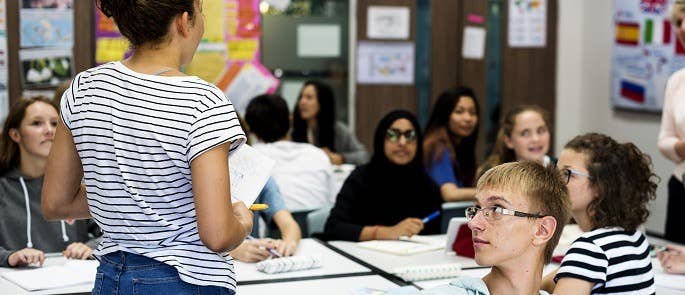
What Are the Steps of Genius Hour?
Genius hour can generally be split into five steps: proposing, researching, creating, presenting, and reflecting.
Planning and Researching
During the proposing (or planning) stage, students will need to select a topic they want to work on. This may involve brainstorming a range of ideas and choosing a couple of them to submit for your approval – you can help to decide whether a topic is too big or too small for the amount of time they have, and whether or not it will sustain their interest and build their skills. Students will also need to decide on the question they are looking to answer with their project. Having a central question to go back to will help to focus their research – however, you should ensure that their question is not something that Google could answer in one search.
At the research stage, students might use a variety of different mediums to find out about their topic. This could include books, articles, websites, videos, or even experts on the subject (either in the local community or those you find online) – interviewing someone gives them valuable experience and helps them see how their chosen topic relates to the real world. Your students should keep detailed notes so that they don’t forget what they have learnt; this will also help to prepare them for future study. You might also decide to teach them how to reference and how to evaluate the accuracy of a source.
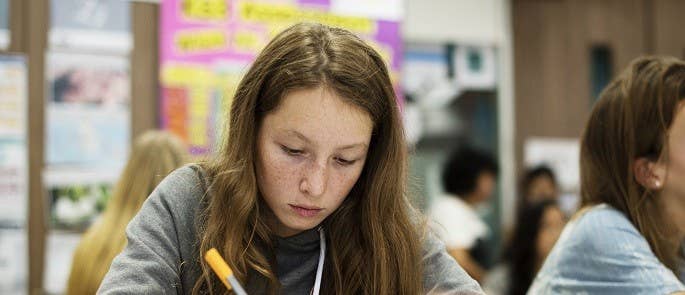
Creating, Presenting, and Reflecting
Once they have finished researching, they can use the data they have collected to create their project. It might be in the form of a PowerPoint presentation, written report, video, painting, or something made out of papier-mâché – it all depends on the project.
The finished product is then presented to the class, teacher, and whoever else you decide to invite (some teachers ask parents and other staff to come in and watch). The students don’t necessarily have to talk through the project in front of the class – they might find this intimidating, and may prefer to simply show it to everyone. Also consider setting a time limit for each presentation, and recording to give each student feedback afterwards.
Finally, ask your students to reflect (whether in a journal, a worksheet, or reflection video): what went well? What did they learn? Would they do anything differently? What is their target for next time?
Ideas & Lesson Plans for Genius Hour
The most important thing with genius hour is to let students explore their interests. Don’t cut the brainstorming short – an idea that they’re passionate about makes the whole process much more valuable. If students can’t decide what to do, try using a ‘wonder wall’ (a space where they put sticky notes with problems they want to solve), websites like Thrively (which show children their strengths), or worksheets with questions to get them thinking (for example, what’s happening in the world currently that you’re interested in? What has made you say ‘wow’ recently?).

We have collated 20 good examples of genius hour projects :
- Create a podcast.
- Write a poem, play, song, story, blog, or whole book.
- Learn a new language or create your own.
- Teach a younger student a skill.
- Build a website or make an app.
- Make your own video game or cartoon (try this website for help with videogames and this for cartoons).
- Learn to code.
- Investigate different careers.
- Paint a picture or learn photography.
- Design a 3D model.
- Create your own board game.
- Create your own sport.
- Watch TED talks and make your own.
- Investigate a time period or event in history.
- Design your own clothes or makeup.
- Learn more about a type of animal you’re interested in.
- Learn how to sew.
- Create, market, and sell a product you design.
- Carry out a science experiment or create a science cookery book.
- Make a sculpture.
Give these initial ideas to your students and see what they come up with – it might help to spark their creativity!
Genius hour is a great way to get your students excited about learning, as well as exploring their own interests, and building their independent learning skills. It might initially seem daunting, but many teachers have found it revolutionary – we hope this article has given you the confidence to try it.
Further Resources:
- Education Training Courses
- 8 Ideas for Building Resilience in Children at School
- Metacognition in the Classroom: Benefits & Strategies
- How to Use Assessment for Learning in Schools
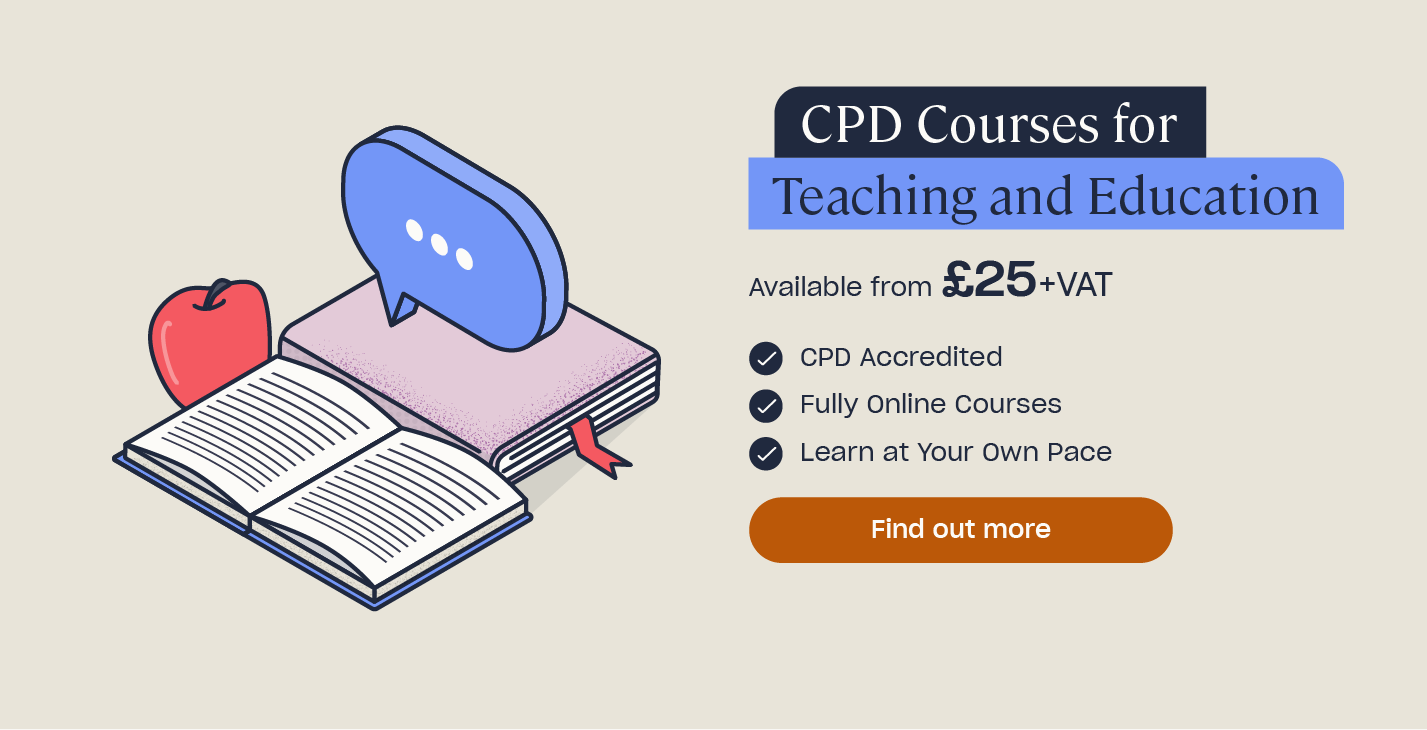
Post Author

Her favourite article is How to Support a Child with Autism in the Classroom
You may also like
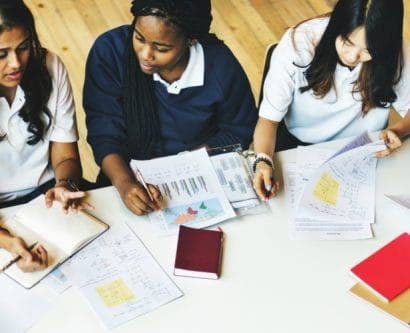
Top 20 Genius Hour Project Ideas For High School [Updated]

- Post author By admin
- April 5, 2024
- No Comments on Top 20 Genius Hour Project Ideas For High School [Updated]
In a world where being creative and thinking of new ideas is really important, Genius Hour gives you a chance to shine and show what you can do. Have you ever wished you could explore your passions and interests freely? Well, Genius Hour is your chance! This blog will guide you through the exciting realm of Genius Hour project ideas, offering inspiration and ideas to help you embark on your own creative journey.
Table of Contents
What is Genius Hour?
Genius Hour is a concept that originated in classrooms but has since spread to various settings. It’s a designated time for individuals to pursue their passions and interests, without constraints or limitations. Whether you’re a student in school or an adult in the workforce, Genius Hour empowers you to explore topics that ignite your curiosity and drive your creativity.
What Are The 3 Rules For Genius Hour?
The three rules for Genius Hour typically revolve around autonomy, passion-driven learning, and accountability. Here’s an explanation of each rule with an example:
Students have the freedom to choose their own topics and explore them in a way that interests them.
In a classroom setting, students are given one hour each week to work on a project of their choice. One student, Sarah, decides to explore the topic of sustainability.
She is passionate about reducing waste and decides to create a composting system for her school’s cafeteria. With the autonomy granted by Genius Hour, Sarah can research composting methods, design her system, and implement it with minimal guidance from her teacher.
Passion-driven Learning
Students are encouraged to pursue topics that they are passionate about, fostering intrinsic motivation and engagement.
Another student, Michael, is passionate about technology and gaming. For his Genius Hour project, he decides to learn coding and develop his own video game. Throughout the project, Michael is highly motivated because he is working on something that he loves.
He spends extra time outside of class learning coding languages and refining his game mechanics, all driven by his personal interest and enthusiasm.
Accountability
Students are responsible for setting goals, managing their time effectively, and reflecting on their progress throughout the project.
A third student, Emily, is interested in animal welfare. She decides to use her Genius Hour time to raise awareness about endangered species. Emily sets specific goals for her project, such as organizing a fundraiser and creating educational materials.
She keeps a journal to track her progress, noting milestones and challenges along the way. At the end of the project, Emily presents her findings and reflects on what she has learned about conservation efforts and the importance of taking action.
What Is The Purpose of Genius Hour Projects?
The primary goal of Genius Hour projects is to foster creativity, innovation, and self-directed learning. By allowing individuals to pursue their interests, Genius Hour encourages autonomy, ownership, and enthusiasm for learning. Whether you’re passionate about science, art, technology, or social issues, Genius Hour provides a platform for you to dive deep into your chosen topic and unleash your potential.
Top 20 Genius Hour Project Ideas For High School
- Sustainable Living Initiative: Develop and implement a plan to promote sustainability within the school community, such as reducing waste, conserving energy, or implementing recycling programs.
- STEM Outreach Program: Create a program to introduce younger students to STEM fields through hands-on activities, workshops, and mentoring sessions.
- Mental Health Awareness Campaign: Raise awareness about mental health issues among peers by organizing events, workshops, and resource drives aimed at reducing stigma and providing support.
- Coding Club: Start a coding club where students can learn programming languages, collaborate on coding projects, and participate in coding competitions.
- Community Garden Project: Establish a community garden on school grounds to promote healthy eating, environmental stewardship, and community engagement.
- Digital Art Exhibition: Curate a digital art exhibition showcasing student artwork created using digital mediums such as digital painting, graphic design, and photography.
- Youth Leadership Program: Develop a leadership program to empower students with leadership skills, decision-making abilities, and community involvement opportunities.
- Renewable Energy Research: Conduct research on renewable energy sources such as solar, wind, or hydroelectric power, and propose practical applications for implementing renewable energy solutions in the school or local community.
- Science Fair Mentorship Program: Provide mentorship and guidance to younger students participating in science fairs by sharing research techniques, experiment design tips, and presentation skills.
- Creative Writing Anthology: Compile a collection of original short stories, poems, and essays written by students and publish it as a creative writing anthology.
- Diversity and Inclusion Workshops: Organize workshops and discussions focused on promoting diversity, equity, and inclusion within the school community, addressing topics such as race, gender, and LGBTQ+ rights .
- Environmental Documentary Film: Produce a documentary film highlighting environmental issues, conservation efforts, and sustainability initiatives in the local community.
- Robotics Competition Team: Form a robotics competition team to design, build, and program robots to compete in regional or national robotics competitions.
- Historical Preservation Project: Research and document local historical landmarks, events, or figures, and develop a project to raise awareness about the importance of historical preservation and heritage conservation.
- Youth Empowerment Conference: Organize a conference or summit aimed at empowering young people to become agents of positive change in their schools, communities, and society at large.
- Entrepreneurship Incubator: Create an entrepreneurship program where students can develop business ideas, receive mentorship from local entrepreneurs, and pitch their startups to potential investors.
- Music Composition Workshop: Lead workshops and collaborative sessions where students can learn music composition techniques, experiment with different musical styles, and compose original pieces of music.
- Debate Club: Start a debate club where students can engage in structured debates on current events, ethical dilemmas, and societal issues to improve critical thinking, public speaking, and argumentation skills.
- Health and Wellness Fair: Organize a health and wellness fair featuring interactive booths, presentations, and activities focused on promoting physical, mental, and emotional well-being among students and staff.
- Podcasting Project: Create a podcast series exploring topics of interest to high school students, such as education, pop culture, social issues, and personal development, and produce episodes featuring interviews, discussions, and storytelling.
What Is A Good Genius Hour Question?
A good Genius Hour question is one that sparks curiosity, promotes critical thinking, and encourages exploration and discovery. Here’s an example of a compelling Genius Hour question:
“How can we use technology to address environmental challenges and promote sustainability?”
This question invites students to delve into the intersection of technology and environmental issues, prompting them to explore innovative solutions, conduct research, and propose practical applications. It encourages creativity, problem-solving, and interdisciplinary thinking, making it an ideal starting point for a meaningful Genius Hour project.
Genius Hour project ideas offer a unique opportunity to explore your interests, unleash your creativity, and make a difference in your community and beyond.
Whether you’re passionate about science, art, technology, or social issues, there’s a Genius Hour project waiting for you.
So go ahead, embark on your creative journey, and let your genius shine!
Leave a Reply Cancel reply
You must be logged in to post a comment.
- australia (2)
- duolingo (13)
- Education (279)
- General (75)
- How To (16)
- IELTS (127)
- Latest Updates (162)
- Malta Visa (6)
- Permanent residency (1)
- Programming (31)
- Scholarship (1)
- Sponsored (4)
- Study Abroad (187)
- Technology (12)
- work permit (8)
Recent Posts

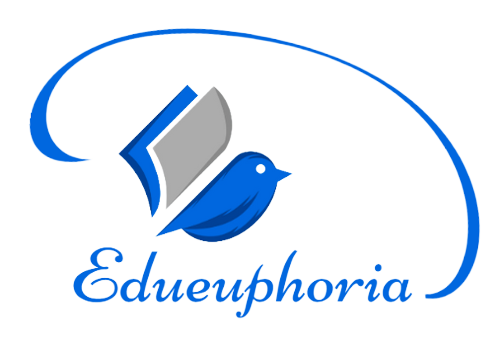
135+ Genius Hour Project Ideas
Genius Hour, also known as 20% Time or Passion Projects, is a fascinating concept that allows students to explore their passions and interests in a school or work setting. During this designated time, learners have the freedom to pursue projects of their choice, sparking creativity, curiosity, and a love for learning. If you’re looking for inspiration or guidance for your Genius Hour project, you’ve come to the right place! In this blog, we’ve compiled a whopping 140 Genius Hour project ideas, so you’re sure to find something that piques your interest.
Table of Contents
What is Genius Hour?
Genius Hour is a special time when students or workers get to choose and work on projects they’re really excited about. It’s like having a break from regular tasks to explore your passions and interests. During this time, you can create art, invent things, study topics you love, or do anything that inspires you. It’s all about discovering, learning, and having fun while becoming more creative and skilled. Genius Hour is a chance to make your own ideas come to life and share them with others.
What are the 3 Rules of Genius Hour?
Genius Hour is often guided by three key principles or rules:
- Choice: Participants have the freedom to choose what they want to work on. They pick projects that genuinely interest and inspire them.
- Passion: The projects should be driven by passion and personal curiosity. This means working on something you truly care about, not just completing an assignment.
- Autonomy: Learners have a degree of independence and control over how they work on their projects. This autonomy encourages self-directed learning and creativity.
135+ Genius Hour Project Ideas
Arts and crafts:.
- Create a series of paintings inspired by nature.
- Design your own fashion line and showcase it in a mini fashion show.
- Craft intricate jewelry using beads, wire, or other materials.
- Sculpt a masterpiece using clay or other sculpting mediums.
- Make your own candles or soap with unique scents and designs.
- Experiment with tie-dye techniques on clothing or fabric.
Science and Technology:
- Build a solar-powered gadget or charger.
- Develop a mobile app to solve a specific problem.
- Investigate the life cycle of a local insect or plant.
- Create a 3D-printed model of something that interests you.
- Explore the possibilities of robotics with a DIY robot project.
- Study the impact of various diets on plant growth.
Writing and Literature:
- Write a novel or short story in your preferred genre.
- Start a blog or vlog about a subject you’re passionate about.
- Create your own comic book or graphic novel.
- Compile a collection of your original poems or essays.
- Write a series of letters to historical figures or fictional characters.
- Analyze the impact of social media on communication.
Music and Performance:
- Learn to play a musical instrument and compose your own music.
- Create a podcast discussing topics you’re passionate about.
- Choreograph a dance routine and perform it.
- Write and perform your own stand-up comedy routine.
- Organize a small concert featuring local talent.
- Produce a short film or video showcasing your storytelling skills.
History and Culture:
- Research your family tree and create a family history book.
- Study a particular era in history and recreate it through a historical reenactment.
- Investigate the history and cultural significance of a local landmark.
- Write a biography or create a documentary about a historical figure.
- Explore the art and culture of a specific country or civilization.
- Curate an exhibit showcasing a particular period in history.
Sports and Fitness:
- Train for a local sports event and document your journey.
- Develop a workout plan for a specific fitness goal.
- Create a guide to nutrition and healthy eating.
- Explore the history and strategy of a lesser-known sport.
- Organize a sports tournament in your community.
- Research the science behind athletic performance.
Nature and Environment:
- Start a composting or recycling project at your school or home.
- Conduct a wildlife survey in your local area.
- Design a sustainable garden with native plants.
- Raise awareness about an environmental issue through art or media.
- Create a documentary on the impact of climate change on your region.
- Study and promote local biodiversity.
Cooking and Nutrition:
- Experiment with cooking or baking and create your own recipes.
- Explore the history and cultural significance of a particular dish.
- Develop a meal plan for a special diet or dietary restriction.
- Create a cookbook or cooking tutorial series.
- Investigate the science of food preservation or fermentation.
- Host a cooking competition or food tasting event.
Math and Puzzles:
- Solve a complex math problem or prove a theorem.
- Create a series of challenging puzzles or riddles.
- Explore the world of cryptography and code-breaking.
- Design and build your own board game or card game.
- Investigate the mathematics behind fractals or tessellations.
- Analyze data and create visualizations for a real-world issue.
Travel and Geography:
- Plan a virtual or physical road trip and document your experiences.
- Explore the culture and traditions of a foreign country.
- Study the geography and topography of a specific region.
- Create a travel blog or vlog showcasing your adventures.
- Learn a new language and immerse yourself in its culture.
- Research and write about hidden gems in your local area.
Psychology and Sociology:
- Conduct a survey or experiment on a topic related to human behavior.
- Create a mental health resource guide for your community.
- Study the impact of social media on mental health and well-being.
- Explore the psychology of decision-making and biases.
- Analyze the portrayal of mental health in popular media.
- Investigate the history and impact of a social justice movement.
Business and Entrepreneurship:
- Develop a business plan for a unique product or service.
- Create a marketing campaign for a cause you’re passionate about.
- Study successful entrepreneurs and their journeys.
- Explore the world of e-commerce and start an online store.
- Organize a small business fair or market in your community.
- Develop a financial literacy curriculum for your peers.
Language and Linguistics:
- Learn a new language and document your progress.
- Explore the evolution of language over time.
- Create a guide to local slang or dialects.
- Study the art of storytelling and oral traditions.
- Analyze the use of language in advertising and media.
- Translate a classic literary work into a modern language.
Artificial Intelligence and Machine Learning:
- Build a chatbot to assist with a specific task.
- Train a machine learning model to classify objects or data.
- Create a recommendation system for books, movies, or music.
- Investigate the ethical implications of AI and automation.
- Develop a project using natural language processing (NLP).
- Study the history and evolution of artificial intelligence.
Fashion and Design:
- Design and sew your own clothing collection.
- Create a portfolio of fashion illustrations or designs.
- Explore sustainable fashion and design eco-friendly clothing.
- Study the history of fashion trends and their cultural impact.
- Organize a fashion show featuring your designs.
- Experiment with upcycling and repurposing clothing.
Health and Wellness:
- Research and promote the benefits of mindfulness and meditation.
- Create a guide to maintaining a healthy work-life balance.
- Study alternative medicine practices and their effectiveness.
- Develop a fitness app or program tailored to specific needs.
- Investigate the impact of sleep on physical and mental health.
- Organize a wellness fair or workshop for your community.
Astronomy and Space:
- Build a telescope or observatory to study the night sky.
- Research and document the history of space exploration.
- Explore the possibility of life on other planets.
- Create a scale model of the solar system.
- Study the physics of black holes and other celestial phenomena.
- Organize a stargazing event for your community.
Film and Photography:
- Produce a documentary on a topic you’re passionate about.
- Learn photography techniques and create a portfolio.
- Experiment with stop-motion animation.
- Study the history of cinema and influential filmmakers.
- Organize a film festival showcasing student-made films.
- Create a photojournalism project on a local issue.
DIY and Home Improvement:
- Renovate or redecorate a room in your home.
- Build custom furniture or home decor items.
- Explore woodworking and create functional items.
- Develop a guide to home maintenance and repairs.
- Study interior design principles and create mood boards.
- Organize a DIY workshop for your community.
Innovation and Invention:
- Solve a real-world problem with a new invention or product.
- Explore the possibilities of 3D printing for practical applications.
- Design a sustainable solution for a common environmental issue.
- Study the history of inventions and their impact on society.
- Create a prototype for a unique gadget or tool.
- Organize an invention fair or showcase.
Education and Teaching:
- Develop educational materials or resources for a specific subject.
- Create a YouTube channel or educational website.
- Study innovative teaching methods and their effectiveness.
- Organize a tutoring or mentorship program for peers.
- Research the history of education and educational reform.
- Design a curriculum for a unique course or workshop.
Community Service and Volunteering:
- Start a community garden or beautification project.
- Create care packages for local shelters or hospitals.
- Organize a charity event or fundraiser.
- Volunteer at a local nonprofit organization.
- Develop a campaign to raise awareness about a social issue.
- Study the history and impact of volunteerism in your community.
Hobbies and Collecting:
- Showcase a collection of unique or vintage items.
- Learn a new hobby or craft and document your progress.
The world is full of endless possibilities, and Genius Hour gives you the opportunity to explore your interests, develop new skills, and make a meaningful impact. Whether you’re drawn to the arts, sciences, technology, or any other field, there’s a Genius Hour project waiting for you. So, don’t be afraid to dive into your passion, get creative, and let your curiosity guide you. Who knows, your Genius Hour project might just be the first step toward a lifelong passion or even a future career!
Leave a Comment Cancel reply
Save my name, email, and website in this browser for the next time I comment.
Your Top 10 Genius Hour Questions Answered
November 6, 2016
Can't find what you are looking for? Contact Us
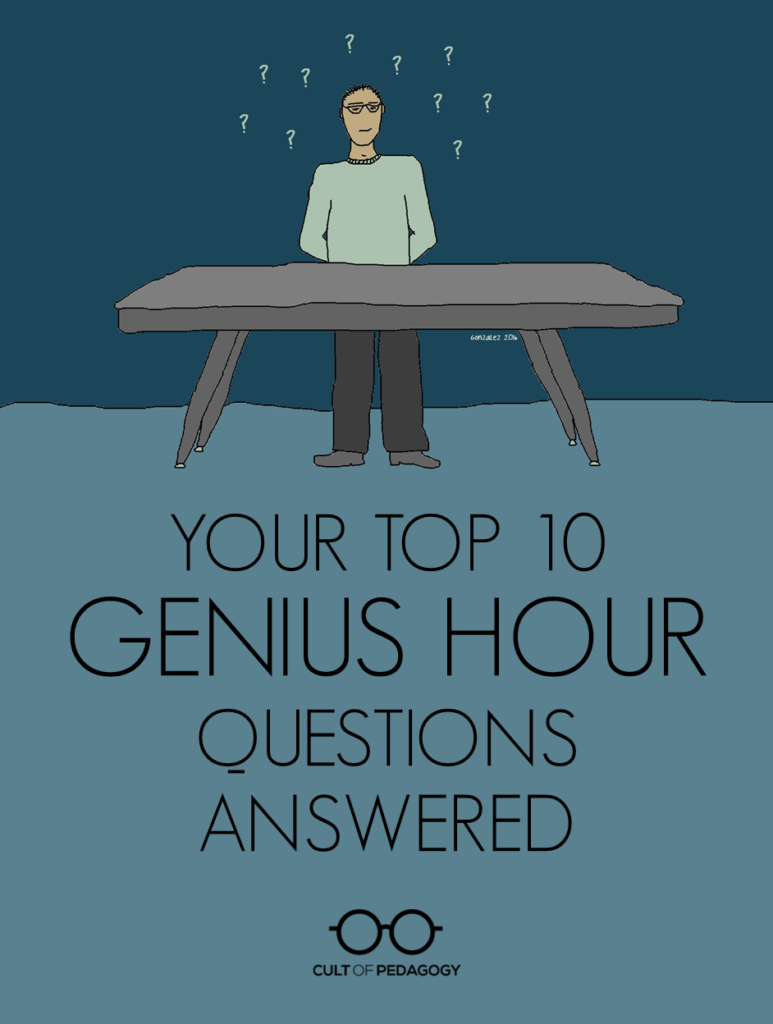
Listen to the interview with A.J. Juliani ( transcript ):
We hear all the time about how we need to give students more choice. About how we should be helping them discover their passions, how we need more student-directed, inquiry-based learning in the classroom. But all of that can feel like a load of abstract, pie-in-the-sky hooey without practical instructions for how to actually do it. We need a structure, a format, a plan for delivering this kind of experience.
Good news: That plan is here, and it’s called Genius Hour. More and more teachers are implementing this brilliant learning practice in their own classrooms. Chances are, you already have a pretty good idea of what Genius Hour is. You might even have it on your list of things to try “some day.” If that day hasn’t come yet, it’s probably because you have some unanswered questions.
So to help you out, I invited my friend A.J. Juliani to answer the 10 most frequently asked questions about Genius Hour. A.J. is the Director of Technology and Innovation for Centennial School District in Bucks County, Pennsylvania. He did his first Genius Hour project back when he was an 11th grade English teacher, and since then has supported many other teachers as they implement Genius Hour in their own classrooms.
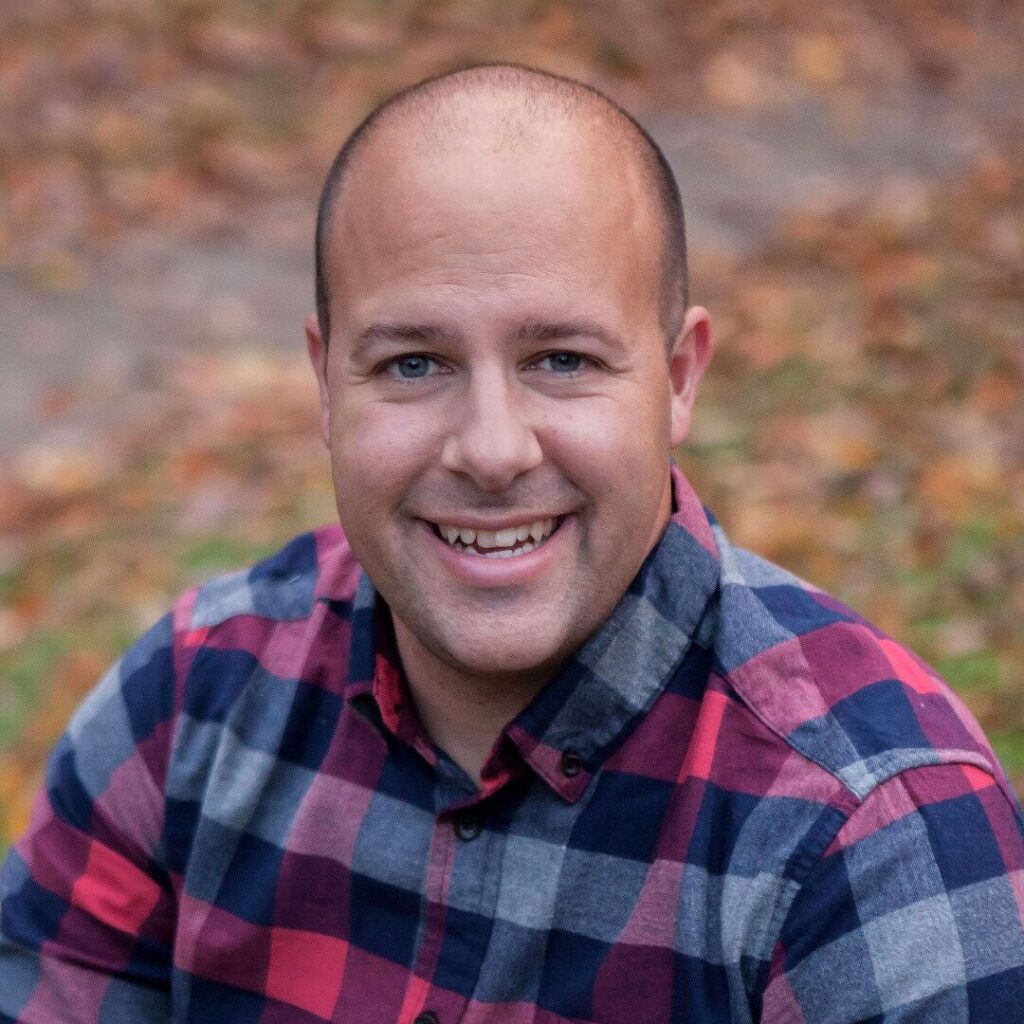
Now A.J. has created a full online course, the 1-Day Genius Hour Course , where he walks teachers step-by-step through the implementation process. (Learn more about the course at the end of this post!) The teachers who are already enrolled are seeing incredible results with their students, so I wanted to share some of A.J.’s wisdom with you and maybe get you one step closer to trying Genius Hour in your own classroom. To learn more about the course, scroll to the bottom of this post. In the meantime, there’s plenty here to keep you busy!
1. What is Genius Hour? Is it different from 20 percent time?
Genius Hour is a teaching practice that has absolutely exploded in popularity over the last couple of years. It’s where the teacher sets aside a certain amount of time every week or every day—maybe one class period per week or one hour per day in an all-day classroom setting—for students to learn about whatever they want. “There are lots of terms for it,” Juliani says. “Genius Hour and 20 percent time are probably the terms people are using right now the most for this kind of inquiry-based learning, but that’s really what both are at their heart.”
2. Is Genius Hour just “do whatever you want,” or is there a way to structure it?
If teachers want a Genius Hour project to be successful, they definitely need to structure it. “Even though students get to choose, and they have the freedom of choice,” Juliani says, “the project is very, very much structured and put together. And I think it has to be in order for students to actually have the ability to get to the final end result.” In our interview, he outlined how the basic structure works:
Step 1: Planning First, Juliani says, teachers need to decide how much time they are going to set aside, and when that’s going to happen. “Whatever works in your classroom, in your school, with your curriculum, I think dictates how much time.”
Step 2: Topic Selection After introducing the project to students, they choose what they are going to learn and what product they are going to create at the end to demonstrate their learning.
Step 3: The Pitch Next comes the “Shark Tank” phase. Juliani explains how this works: “Each student either puts together four slides, and it’s 30 seconds to a minute long, and basically what they tell their peers in the class is (1) What they’re going to make, what they’re going to learn. (2) Why they’re going to learn it. Why they want to learn it. Why they want to make what they’re going to make. (3) How they’re going to go about doing it, kind of a brief schedule of how they’re going to get there. And (4) What would be a success in their mind?”
Step 4: Research, Learning, and Documentation Now students start learning the thing they said they were going to learn. “Kids might go to the library and research some things, or they may pull out technology and research,” Juliani explains. “The teacher really facilitates where they’re going to research and kind of get information. They could be watching videos. They could be talking to people who are experts. They could be reading books or articles. So research doesn’t have to be typing something into a database. There’s lots of different ways students can research the world.”
At the same time, students are also sharing their progress along the way. “You want to have them documenting in their journal, sharing on a blog, doing videos and sharing them on YouTube, doing a podcast,” says Juliani, “because they want to share out what they’re doing with the world. You don’t want to keep this hidden. You want to actually put it out there.” Doing this builds classroom community and helps students learn from each other.
Step 5: Making “You don’t want to spend too much time in the research phase, because you really want to get into the making, creating, designing phase and start building your project into a reality,” Juliani says. “For many students, this is where they get a little bit fearful, right? They’re scared that they’re going to fail. They’re scared it’s not going to turn out well. And so what I suggest is you put up what we call ‘epic failure’ boards. As the teacher, you share out when you fail, and you get kids, every time they come in the class for Genius Hour, putting up on there, ‘Hey, here’s how I failed on my project this week.’ And you’re celebrating those failures as steps toward success.”
Step 6: Presentations After the students have made their final products, they present them to their peers. The presentation can take a lot of different forms, Juliani says. “I’ve seen classrooms do TED-style talks where they live stream students doing three- to five-minute presentations and classrooms do gallery walk museum, wax museum, inviting parents in, community members, and putting it out there.”
Step 7: Reflection “After the presentation,” Juliani says, “you have to take time to show the world what you made, what you did, and also reflect. What went well? What did you learn? What do you want to keep on learning? How’s this going to keep growing?”
3. How do I grade Genius Hour work?
Those in the Genius Hour community handle this one differently, and whether or not this kind of project should be graded at all is still up for debate, but Juliani recommends that teachers grade students’ work during the whole process, rather than the final product. To do this, he uses something called a GRIT rubric. “It’s an acronym, and it stands for guts, resiliency, integrity, tenacity. It allows you to grade the process of students each and every time they come in or overall on, basically, are they having guts in the process? Are they actually taking on a challenge? Are they having integrity? Are they not cutting corners? Are they following through? Are they having the tenacity to go after something big? And are they having the resiliency if things don’t go well to bounce back?”
4 & 5. How do I find time for Genius Hour in an already packed schedule? Can Genius Hour meet my required standards?
For some teachers, Juliani says, a Genius Hour project is a natural fit with existing coursework. This would be the case in an all-day elementary classroom or in any English language arts class, regardless of the grade level, because nonfiction reading and writing are being emphasized so much these days in many standards. In other classes, teachers may need to get more creative. “There was one elementary school that really couldn’t fit it into their typical elementary school day, until the librarian said, ‘Hey, I’m going to do it during my library block.’ Library connected to research, connected to reading, and it fit right in there. I had a middle school science teacher tied it to the lab work that they do, where they research something and they create something in kind of the STEM subjects, and so they connected it there. So I think it’s first just finding those pieces in your curriculum that overlap with inquiry and kind of seeing where it could fit in there. It’s going to be different for everyone.”
Teachers may also use Genius Hour as a special project during times when it’s harder to get much academic work done. “A lot of folks have chosen to do Genius Hour projects in their class right around the time of state testing. It’s a way for students to learn and have fun and actually be thoroughly engaged in school during that window of time that traditionally is just not that fun for kids.”
As for standards, “This project hits so many of the common core and other types of standards,” says Juliani. “Everything from standards that connect to reading and researching, standards that connect to analyzing and applying. Standards that connect to writing and presenting, creating and evaluating. And then you have standards for mathematical practice, ones like construct viable arguments and critique the reasoning of others. Another standard for model of mathematics. So you’re hitting a lot of them in a Genius Hour project.”
6. What if students want to study something weird or inappropriate?
Juliani believes we shouldn’t reject a topic right off the bat if it’s something unusual or completely unfamiliar to us; we might just need to learn more about it or send students to someone who shares their interest. “If you get a topic like that, and you’re kind of really uneasy about it and not really sure, talk to some other teachers, talk to some professionals and see.” But if it’s inappropriate, he says, reinforce the idea that although they have free choice, the choice has to be something appropriate for a school assignment. “Just say, ‘Hey, this is still school. It’s got to be appropriate.'”
7. What if students just slack off instead of working?
When students don’t take to Genius Hour right away, Juliani advises us to proceed slowly. “ Just focus on the kid, because if they’re not invested in this, there’s probably some other things going on. So it’s about coming alongside of them as a guide and a real teacher and building that relationship first, then those other pieces start to fall into place as you kind of work with them.”
He recommends three strategies for helping students who get stuck or seem uninterested in the project:
- First, talk with the student about life , not the project. “I think often we want to kind of just jump ahead and kind of force them down a path, but Genius Hour is as much about students finding what they’re passionate about as it is about them kind of finding themselves. So I would talk with a student about life. ‘Hey, what’s going on at home? How are things going?’ Talk to them about their interests. Come to find out what they’re interested in.”
- If that doesn’t get the student back on track with a topic they’re truly invested in, the next step would be to ask them for help . “If they’re not going to be able to work on a project, I wouldn’t just let them sit there. I’d say, ‘Hey. If you’re not going to work on a project, let’s go help somebody else. Let’s see what John’s doing over here or see what Susie’s doing over here, and let’s go.’ And that lets them know in just a nice and friendly way that, ‘Hey, I’m not giving you an F for this project, but you’re going to do something. You’re either going to do what you want to do, or you’re going to help somebody else.'”
- Finally, “I’d help them find a new purpose . Sometimes they get stuck on the passion part. They get stuck on ‘I’m not really that interested in something.’ And so now I’d start the opposite way, which is, ‘Let’s find a purpose. What have you ever wanted to make? What have you wanted to build?’ ‘What job do you want when you’re older?’
8. How do I convince parents, my administrator, or my colleagues that Genius Hour is worth trying?
“When you start this, Juliani says, “tell your colleagues what you’re doing. Invite them in your classroom. Show them other Genius Hour presentations and let them see what the end result of this is. With parents, send a letter home.Tell them what’s going on in your class. Invite them into the classroom. Share your student blogs, give regular updates to your parents, to your colleagues, to your administrator, and then finally invite them into the presentations as well. Whatever type of presentation you’re doing, invite them in, bring them together, share it out with people, be as transparent as possible.”
9. Will this work with younger students?
“In K-2, it works really well,” Juliani says. “Now, the researching might look different. Maybe they’re not reading to research. Maybe they’re watching some presentations, they’re watching videos, they’re looking around the world, right? Their purposes may differ too. They may not want to build a video game or clone carnivorous plants. But their purposes may differ as well. T he end products are going to look different. The presentations are going to look different. But the learning is going to be just as powerful in kindergarten, first and second grade.”
10. How do I get started?
“Start with just a day or two,” Julani says, “Start with an hour where students are just kind of going through this process really quickly. Like, what do you want to learn? Take a whole period just to learn something and tell everybody at the end of the period what you learned, why you wanted to learn it. Just kind of get that inquiry going in the classroom. It doesn’t have to be a full eight-week unit or anything like that. Start small, and bring inquiry and choice into your classroom. It doesn’t have to be a big, long project.” From there, teachers can learn more from the growing community of teachers online who have run successful Genius Hour programs in their own classrooms.
The 1-Day Genius Hour Course
This course equips you with everything you need to run a successful Genius Hour program in your classroom: step-by-step instructions, printable and digital downloads to help you get organized, plus membership in a private Facebook community of experienced Genius Hour practitioners who can answer your questions every step of the way.
Get a closer look at the course
* I am an affiliate for the 1-Day Genius Hour Course. That means if you enroll after visiting the course through my link, I will get a small commission for referring you.
Come back for more. Join our mailing list and get weekly tips, tools, and inspiration that will make your teaching more effective and fun. You’ll get access to our members-only library of free downloads, including 20 Ways to Cut Your Grading Time in Half , the e-booklet that has helped thousands of teachers save time on grading. Over 50,000 teachers have already joined—come on in.
What to Read Next

Categories: Instruction , Podcast
Tags: differentiation , project-based learning
17 Comments
I am really excited to try out Genius Hour with me science classes. How do teachers deal with materials? Should I provide them or do they bring them in?
Hi Lindsay, Because each student’s projects will be different, it might be hard to supply materials to them. I think part of the learning process could be for students themselves to research what materials are needed for their individual projects and how they might go about obtaining them. Also, if you know you and your students will have limited resources, you may want to restrict students to projects where there is little need for physical materials — learning skills and concepts online, for example. Does that help?
Quick question…could I frame the topics in a category? (Give them a broad range but this would help me conquer two birds…) For example, I am all about the Common Good and Community Service. Would this be appropriate or violate the premise of Genius Hour?
PS- I still want to talk about “RETIREMENT CLOUD” …LOL Although I have found my answer….I am “EMBRACING CHANGE”! No matter what… I follow this mantra and it has so helped me! I also know I am NOT ready to retire because I am so pumped about planning for this new school year! I am also developing a PD (hopefully more than just in my school) on the Women of the American Revolution! Be well my friend!!
Best, Maura
Maura! You just said what I’ve been thinking this past year. I’m very close to retiring but I found Skype In The Classroom [mystery Skype, Virtual Field Trips, Guest speakers], and also Flipgrid and it changed the way I teach! So much excitement and new learning going on! I was starting to get tired and just counting the days ,,,and now,,,a total 360,,,I feel like a brand new teacher, motivated, high energy, looking forward to the next day! We Skyped with over 40presenters this year, from all over the world. We made a flag and it flew in the Antarctic, we were part of the global read aloud, the UN global goals, we had a songwriter come in and we wrote a song about Peace and it’s on YouTube now, we Skyped with a geologist in the Virgin Islands and he sent us rock samples!…I could go on and on… I worried that I wasn’t doing what the other teachers were doing, but my instinct told me, this was right for the kids, and the curriculum fell into what we were doing just like it would have if I had used text books and photo copied sheets. Anyway, this year has been a blessing and with 14 days to go, I’m looking to do the same thing in September! Genius Hour btw, awesome idea.
I am so happy to see this encouraged. I tried it twelve years ago with 3rd graders after hearing about GOOGLE using it and continued for the next five years I taught in a classroom. It was great to see students setting up chess lessons, trying out music on various instruments, researching, creating service projects. Well worth the investment in class time. I’m back in the classroom and ready to start this up again!
Awesome, Charlene! I’m so happy for you and your students!
I tried Genius Hour (20Time in my classroom) last year with my high school freshmen. While it was a big hit with many of my students, I felt my implementation of the process needed fine-tuning before I tried it again. Some students’ projects fell flat, and I didn’t feel like I had the know-how and resources to help them perform at their best. I was going to take a break from 20Time this year to research and revamp for next year. BUT after seeing this course, I got so excited and didn’t even hesitate to enroll! I’ve already started thumbing through the materials, and I’ve got a new excitement to put it into practice this year! Thanks for the new direction and the discount! I can’t wait to bring 20Time back to our classroom third trimester!
Kathleen, I’m so excited for you! And I’m thrilled that this year’s students are going to have this opportunity. Please come back and tell us how it goes!
I am a veteran teacher of 37 years…for the past 12 years I have been teaching kindergarten. I fully support this practice of teaching. How might I implement The Genius Hour in Kindergarten?
LOVE Genius Hour with my 8th graders!! This will be my 5th year of having the kids study and share their topic of passion with classmates and our school/parish community at our annual night to share….We start in September and finalize in May with TED talks being filmed by the students. (We’re also a TED-ED class!) I have a timeline on our G.H. bulletin board that keeps the program structured enough so that the kids are successful at completing every component of the project. But I still provide enough flexibility so that the kids can make choices along the way. One of the most impressive and significant outcome of this year-long project is how well the kids do with formal presentations that they are required to give. I guide them through public speaking skills and strategies. They come back after graduation to tell me that they are SO glad that they did their G.H. work because doing projects and presenting them in their high school classes is “no big deal”…their confidence levels soar. I just joine the Genius Hour Master Course for the discounted fee of $100…I am blown away by all of the resources and information provided, even for someone like me who has done this for a few year now…am always looking for ways to make the program better for the kids!
Ooops…caught a couple of mechanical errors in my post…ugh! It’s almost midnight and I’m tired…plus I’m typing fast as this G.H. topic is so exciting to me….even after having taught for 40 years and loving it when I come across such meaningful activities for my 8th graders!!
Hi I am so grateful for all the information you shared here about GH. I am the CAS, Co curricular and Community Service coordinator for our school and I am simply in love with the many opportunities and possibilities GH have to offer. I am learning while implementing in our school. Cant wait to share what we are doing here in our school.
Sending my love to you all from Ghana/West Africa
Genius Hour is the perfect type of project for a collaboration with your school librarian! Please don’t overlook the valuable resources in your school library and your school librarian’s expertise.
Students will be able to share the brainstorming ideas that will be incorporated into the projects.
Hi Jennifer, Thank you so much for posting such amazing things on your blog! I just subscribed today and am looking forward to receiving your monthly emails! I have been struggling with finding time to add genius hour into our day and really enjoyed learning how A.J. had suggested fitting it in a packed schedule Thank you for your help! Toni
my teacher’s making me look for projects on this but i don’t know what it is or what to do. i’m a freshman. this kinda helped so thank you :)))))
Hello Jennifer! I absolutely love yours idea and would really like to implement it. However, I am teaching MS World History at a university model school and only have three 60 minute classes per week. Any suggestions on how to do genius hour under these time constraints? Thank you!
Leave a Reply
Your email address will not be published.
Discover the freshest content on the Inspiring Inquiry website today! Check out the "What's New" page.
Genius Hour
Back To Tools/Strategies
Genius Hour Explained
Also called 20% Time or Passion Projects, Genius Hour stems from a practice at Google. Employees were allowed to use 20% of their work week to explore projects of their choosing, as long as it benefited the company. Gmail, Adsense, Google News, Google Glass and other innovations were created as a result of this self-directed research time.
to promote, support and model creative, innovative thinking and inventiveness
to allow students an opportunity to discover/investigate one of their passions and reflect on/share their learning with others
provide students and teachers an opportunity to develop skill sets** that are valuable in any learning situation (research, experimentation, collaboration, creativity, problem solving and critical thinking). **[T hese skill sets connect to the PYP ATLs and ideally should be explicitly taught prior to implementing Genius Hour - for example research skills could be taught during previous UOIs. This will provide students with prior knowledge about various research strategies as they dive into their passion project. The goal is to use Genius Hour as a vehicle to develop each student's disposition of when to apply a learned skill that will lead the best outcome. A. J Juliani wrote in his blog that we should reimagine Genius Hour as PBL Mastery Hour where the end point is a greater mastery of concepts, skills and ability.]
The goal of Genius Hour is to engage students through inquiry problem solving and critical thinking. Many students are interested in science but may want to pursue a branch of science that is not covered during the typical class curriculum. Genius Hour allows students the flexibility to choose a topic, research the content that is necessary to learn about their topic, and then solve a problem or present about a topic they are passionate about without the constraints of the typical teacher driven instructional time.
In-Class Project
Genius Hour is a student-driven research project done at school and allotted 1 hour a week of class time. Students will be asked to select and pursue a science topic they feel passionate about. This project may be simply research-based or students may look into an answer to a problem, but each project will include a student generated question. Projects will be graded for participation and require an outcome at the end. Students will present their project to the class and create a version of their presentation that can be placed on the web and shared with others.
What is Genius Hour?
Reasons For Genius Hour
Genius Hour Guide-Book
6 Steps to Genius Hour Poster
Review/Purchase
Genius Hour Guidebook
The Genius Hour Guidebook, written by Denise Krebs and Gallit Zvi shows you how to implement Genius Hour – a special classroom time when students can develop their own passion-driven, inquiry-based projects and take more ownership of their work and their learning.
T he book takes you step by step through planning and facilitating Genius Hour. You’ll learn how to guide your students as they:
Develop inquiry questions based on their interests;
Conduct research to learn more about their topic of choice;
Create presentations to teach their fellow students in creative ways; and
Present their finished product to the world!
At the end of The Genius Hour Guidebook, you’ll find handy FAQs and ready-made lessons and resources. In addition, this companion website, geniushourguide.org , the book offers bonus materials and regular updates to support you as you implement Genius Hour in your own classroom.
Genius Hour Beginner's Guide
Genius Hour Blueprint - Slides
Genius Hour LiveBinder
Video Presentation: How to Navigate the LiveBinder
5 Ways Student Choice Impacts Learning | AJ Juliani | Choice gives students the ability to go above and beyond our curricular limitations. Learn about five specific ways student choice impact s learning .
5 Ways To Launch Your Genius Hour Projects to the World
Genius Hour - For Students
Bigger definition of creativity.
Genius Hour Introduction 1
Genius Hour Introduction 2
Genius Hour Introduction 3
Genius Hour Introduction 4
Genius Hour Self Assessment
P icture B ooks to I ntroduce Genius Hour
Picturing genius.
Elementary teacher and vice principal Gallit Zvi uses these seven picture books to introduce her students to Genius Hour.
The Most Magnificent Thing , by Ashley Spires. - “This book is perfect for teaching persistence, risk-taking, and flexibility. I read it after introducing Genius Hour.”
What Do You Do With an Idea? by Kobi Yamada, illustrated by Mae Besom. - “Handy to read to your class if they’re needing some fresh inspiration for Genius Hour.”
Rosie Revere, Engineer , by Andrea Beaty, illustrated by David Roberts. - “Use it to introduce a discussion on inquisitiveness, risk-taking, and generating ideas.”
Q Is for Question: An ABC Book of Philosophy , by Tiffany Poirier . - “I make sure this book is on hand for students to flip through when they need inspiration.”
It’s Okay to Make Mistakes , by Todd Parr . - “It helps us learn that even if things don’t go the way we expected, that’s part of trying new things!”
The Dot , by Peter H. Reynolds . - “So many teachers love this book [about starting small and building on an idea] that it has its own day—International Dot Day on September 15.”
Iggy Peck, Architect , by Andrea Beaty , illustrated by David Roberts. - “This is a great book to introduce the concept of passion.”
Additional Genius Hour Resources
This could fail.
Learning is Messy Poster
Growth Mindset: Learning Like A Skater
The Five Biggest Mistakes I Made
Download Resources
Back to Top
- WordPress.org
- Documentation
- Learn WordPress
- Members Newsfeed
What Is a Genius Hour And How Can I Try It in My Classroom?
- Uncategorized
Genius Hour is an innovative approach to education that allows students to explore their interests and pursue passion projects during designated class time. It originated from the concept of Google’s 20% time, where employees were given freedom to work on personal projects. In a Genius Hour setting, students are encouraged to generate their own questions, conduct research, and engage in hands-on activities related to their chosen topics.
One of the primary goals of Genius Hour is to promote a student-centered learning environment, where students have the autonomy to direct their own learning and shape their educational experiences. By giving students the opportunity to delve deeply into subjects they are genuinely curious about, Genius Hour fosters intrinsic motivation and ignites a love for learning.
Implementing Genius Hour in the classroom involves several key steps. First, teachers need to introduce the concept, explaining the purpose and benefits of this approach. It is crucial to create a supportive and encouraging atmosphere, where students feel comfortable taking risks and pursuing their passions.
Next, students are provided with dedicated time to work on their projects. This can be a designated period each week or integrated into existing curriculum through project-based learning. During this time, students engage in the research process, collaborate with classmates, create prototypes, or produce tangible outcomes such as presentations, videos, or models.
Teachers play a vital role in supporting students throughout their Genius Hour journey. They act as facilitators, guiding students towards resources, asking thought-provoking questions, and providing feedback. By nurturing curiosity and critical thinking skills, teachers empower students to independently navigate complex topics and make meaningful connections.
To ensure the success of Genius Hour in the classroom, it is important to establish clear expectations and create checkpoints for students to share their progress. This can be done through regular presentations, discussions, or peer evaluations, allowing students to showcase their work and receive valuable input.
Implementing Genius Hour not only allows students to explore their passions, but also develops a range of essential skills. By engaging in self-directed learning, students enhance their research and information literacy skills, improve time management and organization, and cultivate creativity and problem-solving abilities.
To try Genius Hour in your classroom, start by identifying the objectives and desired outcomes for your students. Encourage them to brainstorm topics they are passionate about and guide them in formulating compelling questions to investigate. Provide access to resources, materials, and technologies that support their chosen projects. Regularly check in on student progress, provide support and feedback, and celebrate their achievements.
Integrating Genius Hour into your classroom can be a transformative experience, as it taps into students’ intrinsic motivation and empowers them to take ownership of their learning. By embracing curiosity, creativity, and autonomy, Genius Hour opens doors to endless possibilities and creates lifelong learners.
Related Articles

Father’s Day is celebrated to appreciate and honor the affection, love, and…

Ensuring that students are well-rounded and knowledgeable about various aspects of society…
Mother’s Day and Father’s Day are significant occasions where individuals celebrate their…

Pedagogue is a social media network where educators can learn and grow. It's a safe space where they can share advice, strategies, tools, hacks, resources, etc., and work together to improve their teaching skills and the academic performance of the students in their charge.
If you want to collaborate with educators from around the globe, facilitate remote learning, etc., sign up for a free account today and start making connections.
Pedagogue is Free Now, and Free Forever!
- New? Start Here
- Frequently Asked Questions
- Privacy Policy
- Terms of Service
- Registration
Don't you have an account? Register Now! it's really simple and you can start enjoying all the benefits!
We just sent you an Email. Please Open it up to activate your account.
I allow this website to collect and store submitted data.
- Our Mission
6 Tips for Getting Started with Genius Hour
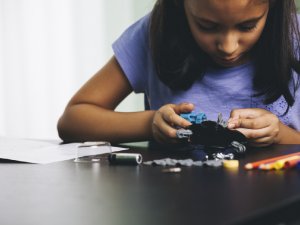
Genius hour is a great way to allow students to drive their own personalized instruction but where to begin such a big project?
How to Get Started
There are a lot of resources out there already, and most of the teachers that are embarking on this process are willing to share what they have or help you problem solve.
The following all have something to offer:
- Joy Kirr's livebinder for Genius Hour is a great place to start
- #geniushour on Twitter
- 20% Time on Google+
- Genius Hour - Passion Based Learning
- Cybrary Man has a good collection of places to look too
Practical Tips
- Face to Face time is invaluable: While the students are working independently you are still there helping them focus and problem solve. The relationships you build with them come into play here. You will be using that genius hour time to work with them, conference with them, and help them reflect on where they are at in the process.
- Let Go: You have to learn to let go of the process at a certain point and be fine with letting the kids work at their own pace. Some get stuck in parts and take awhile to get over the hump; while others are zooming ahead.
- Think about your benchmarks: How do you want your students to show their mastery of their essential question? For me I had certain items due along the way to keep them on task. A video pitch, an interview, a book to guide their research, and finally a TED style talk to their peers.
- To grade or not to grade? Some people don't agree with grading this project. They want this to be a project that emphasizes the love of learning. I do grade it. Where do you fall in the spectrum?
- Utilize your own social network: Use Facebook, Twitter, Google+ to find mentors and/or people to help with interviews.
- Reflect: Constantly reflect on the process. What is working with your students, what isn't? Not all genius hours will look the same, and I think that is ok. It is about the engagement and creativity for your kids.
This piece was originally submitted to our community forums by a reader. Due to audience interest, we’ve preserved it. The opinions expressed here are the writer’s own.

IMAGES
VIDEO
COMMENTS
15 genius hour ideas. Here is a list of 15 genius hour ideas to help you guide students once they choose a topic: 1. Research your ideal career. Give students the chance to research a career that interests them. After discovering information such as required education, qualifications, average salary and job outlook, encourage them to share this ...
Make sure that students understand the purpose and value of Genius Hour. Step 2: Brainstorm & Finalize the Topics with Students. Allow time for students to brainstorm ideas. Consider using a tool such as Peardeck or Socrative to help them narrow down their ideas to just one.
Genius Hour is an engaging, student-centered way to boost a whole host of 21st-century learning skills. Students have the opportunity to explore their own interests, deepening their learning on a broad range of topics, while simultaneously honing their ability to research, collaborate, communicate effectively, and creatively present their new ...
In order to create their own goals and projects, they need to have a roadmap. That's where these five steps come in. Here is a timeline that you can use (and adapt based on your classroom needs): Brainstorming topics: 2-3 days. Formulate research questions: 4-5 days. Research topics: 1-2 weeks. Create projects: 1 week.
Genius Hour planning sheets and teaching resources to help support implementation of Genius Hour in your classroom. These ideas for Genius Hour will really get your students excited to begin independent learning. ... The coordinating journal page organizes these ideas so students can select topics to generate action research questions about. 2 ...
The Genius Hour process is typically broken out into six steps or phases, facilitated in a way that is easy for students to understand what they need to do. Each step has a ridiculously awesome character that goes with it, as well as a host of resources to support both teachers and students throughout each step. 1:50.
Genius Hour in Elementary School. A teacher shares what she did and what she learned when she implemented Genius Hour in her fifth-grade class. We've all heard legends of Google employees being able to spend 20 percent of their workweek exploring topics of their choosing. Some of our favorite apps were born in this innovative venture.
Genius Hour simply allows teachers to provide students a choice in what they learn and how they learn it during a set period of time within a school day or week. Some teachers allot one class period or one hour per week. Others aim for the 80/20 rule, in which 80 percent of the time is traditional standards-based teaching and learning and 20 ...
The topic was how to do the steps of genius hour at home with students instead of in the classroom. At this time of sheltering... #Geniushour Chat Archive. March 6, 2020. Genius Hour Chat Archive with Dave Quinn - March 2020. Many thanks to Dave Quinn (@EduQuinn) for a great chat this evening about the role of the teacher during Genius Hour. ...
A genius project—also called genius hour (Davis, 2022; Mulvahill, 2018), enigma mission (George Lucas Educational Foundation, 2019), or passion project (Bowersox, 2020; Wormeli, 2018)—is a form of personalized learning in which students engage in sustained, self-directed inquiry for part of the school day.
Using Genius Hour Projects to Help Students Find Meaning. Teachers who guide middle and high school students to work on passion projects see several benefits, including greater learning gains. By Vicki Davis. February 18, 2022. Allison Shelley for the Alliance for Excellent Education. Genius projects are back, and they're better than ever.
Genius Hour projects can be completed during a designated amount of learning time on a regular basis (such as one hour per week), or as a fast finisher activity. During Genius Hour, students identify a topic or problem they are passionate about and form a deep, open-ended inquiry question to research, answer or solve.
The research aspect of genius hour ensures that students develop their skills in finding relevant, reliable sources and evaluating the information given by them. Building social skills and confidence. Genius hour sessions are more like workshops, which encourage collaboration between students when they need help or want to share their ideas.
In step two, students engage more deeply with their selected topic and are supported in moving from a broad topic to a more refined area of study that is suitable for a Genius Hour project. Sometimes called the 'research' stage, this is a chance for students to conduct research to gain a deeper understanding of their project subject.
With the autonomy granted by Genius Hour, Sarah can research composting methods, design her system, and implement it with minimal guidance from her teacher. Passion-driven Learning Students are encouraged to pursue topics that they are passionate about, fostering intrinsic motivation and engagement.
September 23, 2023 by Anya. Genius Hour, also known as 20% Time or Passion Projects, is a fascinating concept that allows students to explore their passions and interests in a school or work setting. During this designated time, learners have the freedom to pursue projects of their choice, sparking creativity, curiosity, and a love for learning.
Step 1: Planning. First, Juliani says, teachers need to decide how much time they are going to set aside, and when that's going to happen. "Whatever works in your classroom, in your school, with your curriculum, I think dictates how much time.". Step 2: Topic Selection.
Genius Hour is an approach to learning where students are guided by their own interests, background knowledge, and curiosity to learn. From the outside looking in, it is less organized, less formal, and less standardized than traditional learning. Genius Hour is truly 'open-ended' learning characterized by student self-direction, passion ...
Genius Hour Ideas for Students. Create a podcast. Teach a younger student a skill. Build a website using WordPress , Wix or Squarespace. Film a science experiment. Make cartoon using Toony Tool. Build a Rube Goldberg machine. Learn to code using Scratch. Create a 3D model and print it.
In-Class Project. Genius Hour is a student-driven research project done at school and allotted 1 hour a week of class time. Students will be asked to select and pursue a science topic they feel passionate about. This project may be simply research-based or students may look into an answer to a problem, but each project will include a student ...
In a Genius Hour setting, students are encouraged to generate their own questions, conduct research, and engage in hands-on activities related to their chosen topics. One of the primary goals of Genius Hour is to promote a student-centered learning environment, where students have the autonomy to direct their own learning and shape their ...
The following all have something to offer: Joy Kirr's livebinder for Genius Hour is a great place to start. #geniushour on Twitter. 20% Time on Google+. Genius Hour - Passion Based Learning. Cybrary Man has a good collection of places to look too. Practical Tips. Face to Face time is invaluable: While the students are working independently you ...
Genius Hour is a project in the classroom and sometimes in a workplace where students or/and employees are allowed to explore their own passions and wonders for a depending amount of time, usually 1 hour per week to 20% of their total class time. Teachers allow students to pick a topic of their own, usually framed around an inquiry question, based on their own passions or wonders.